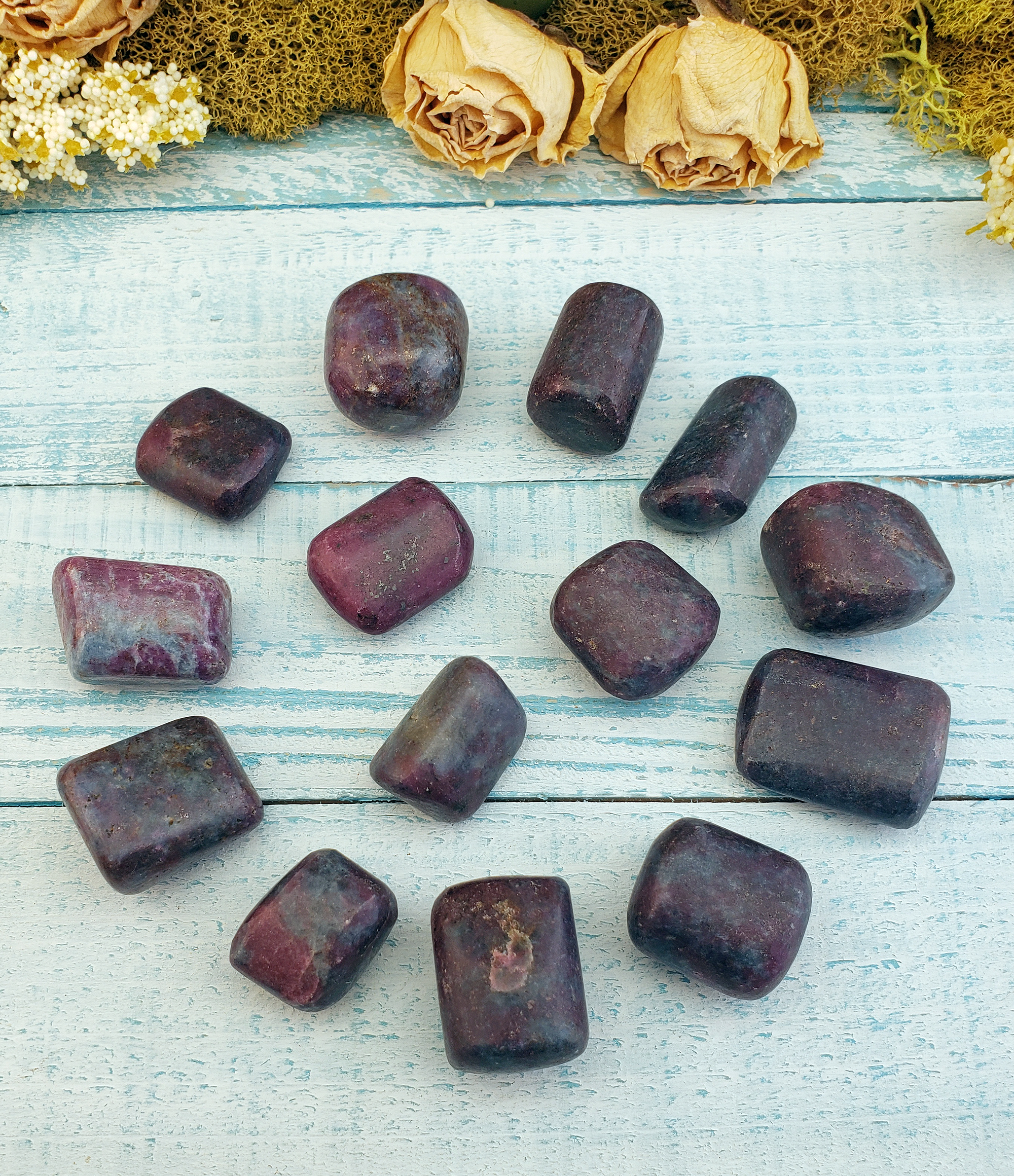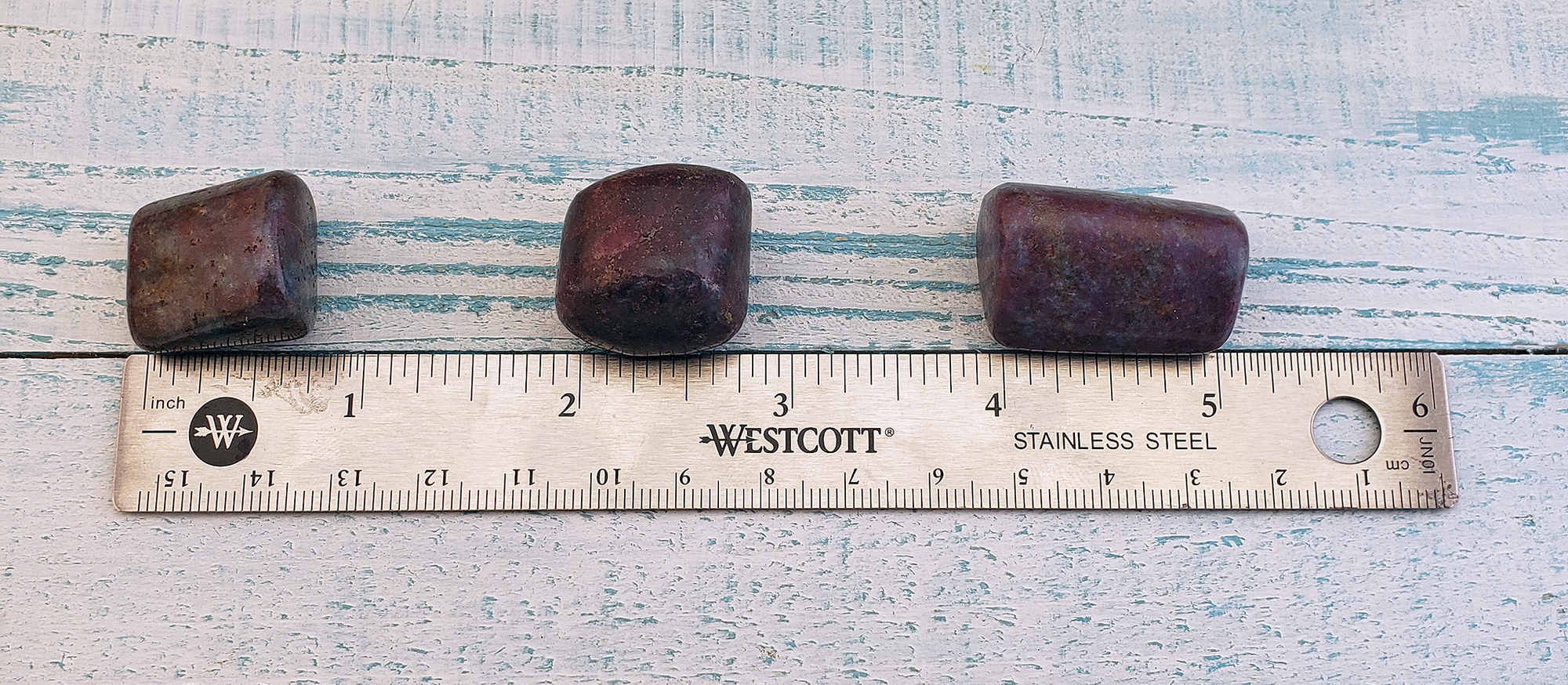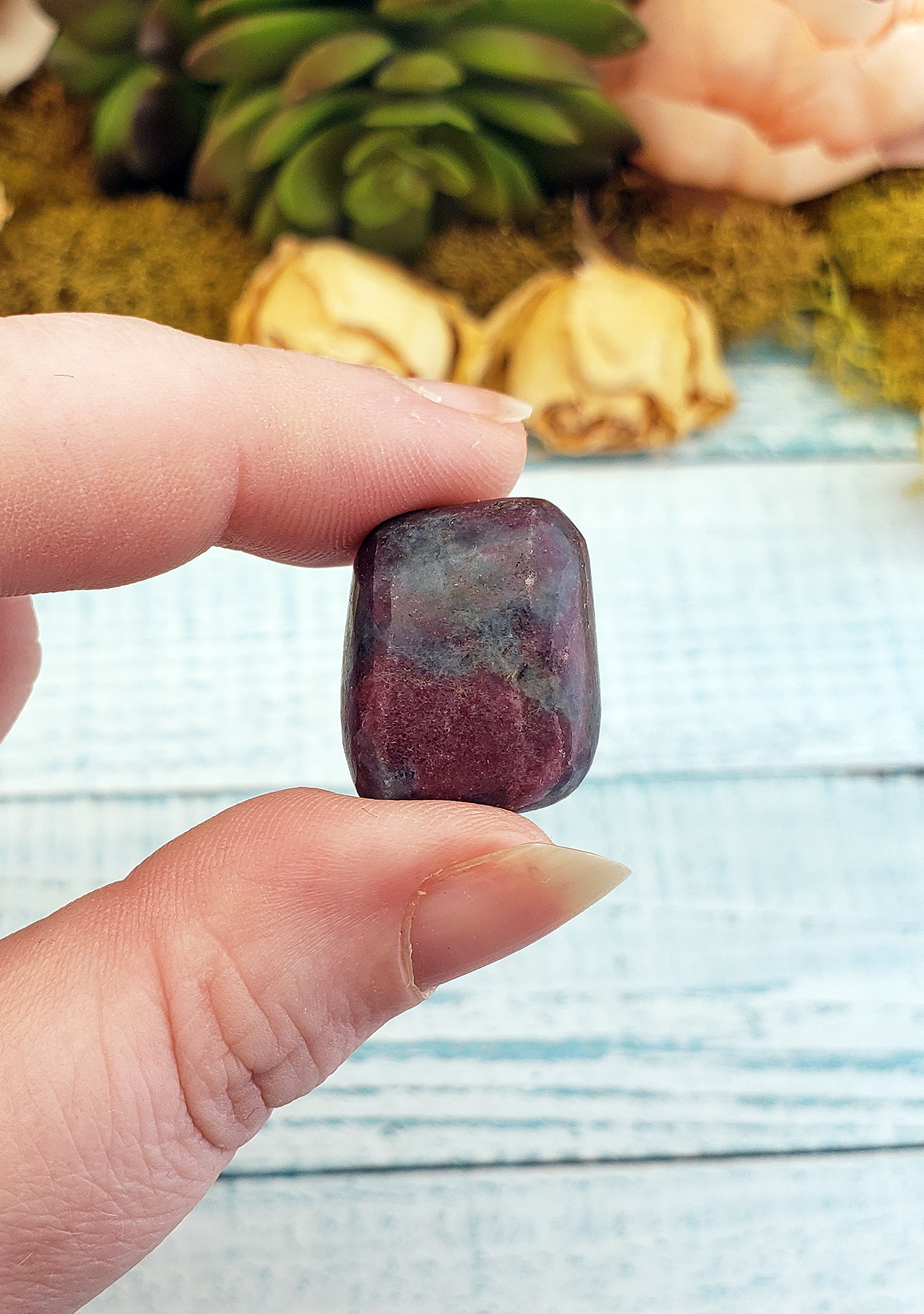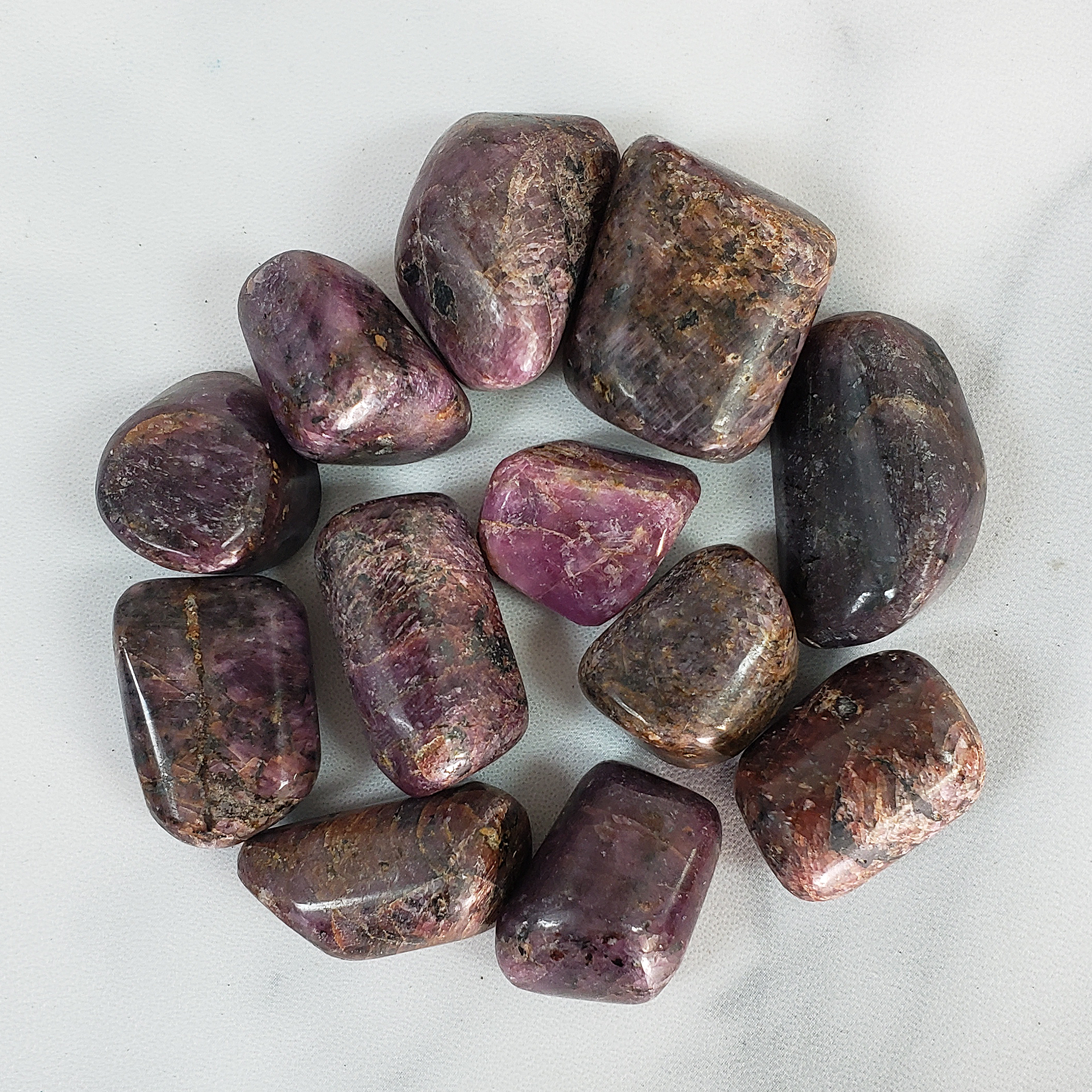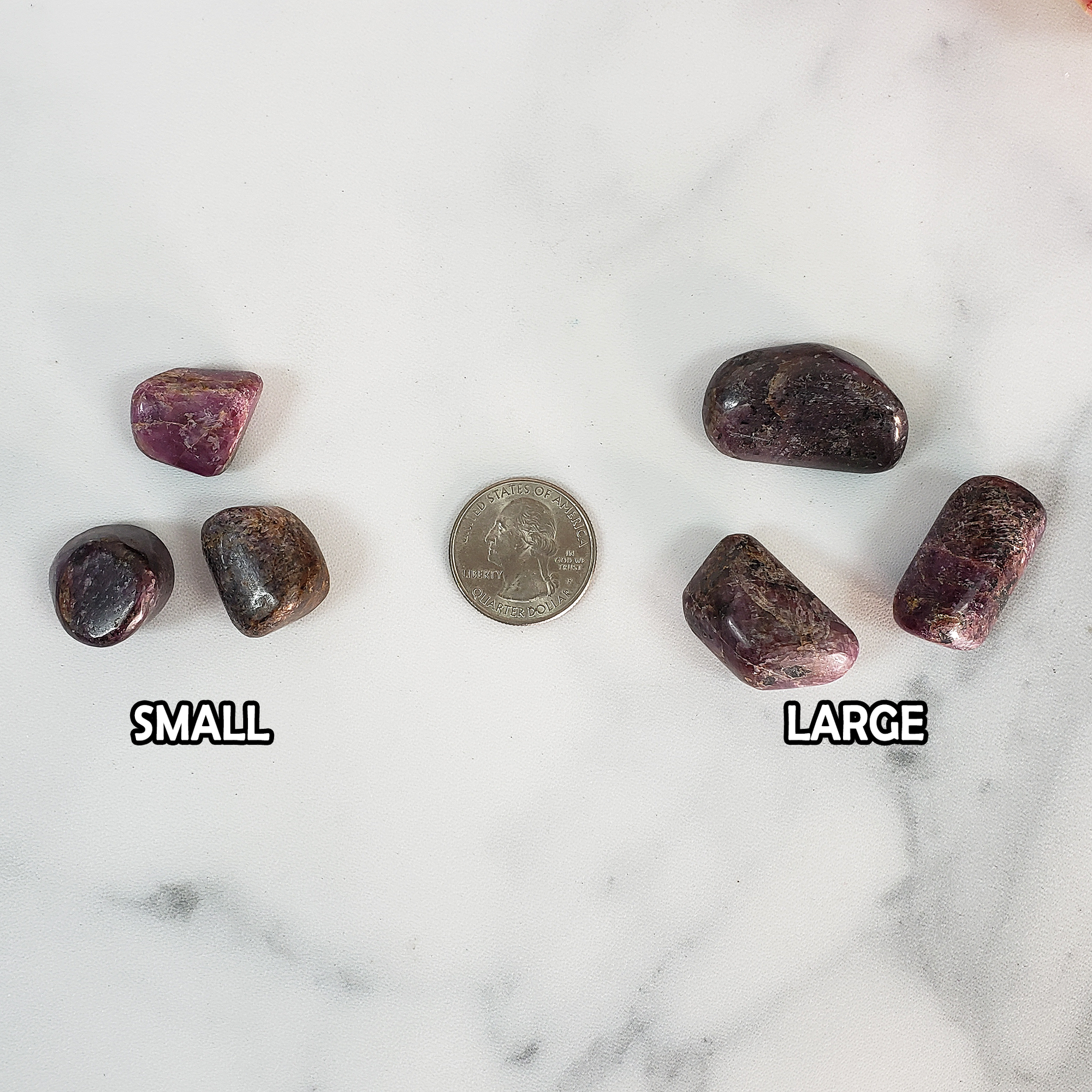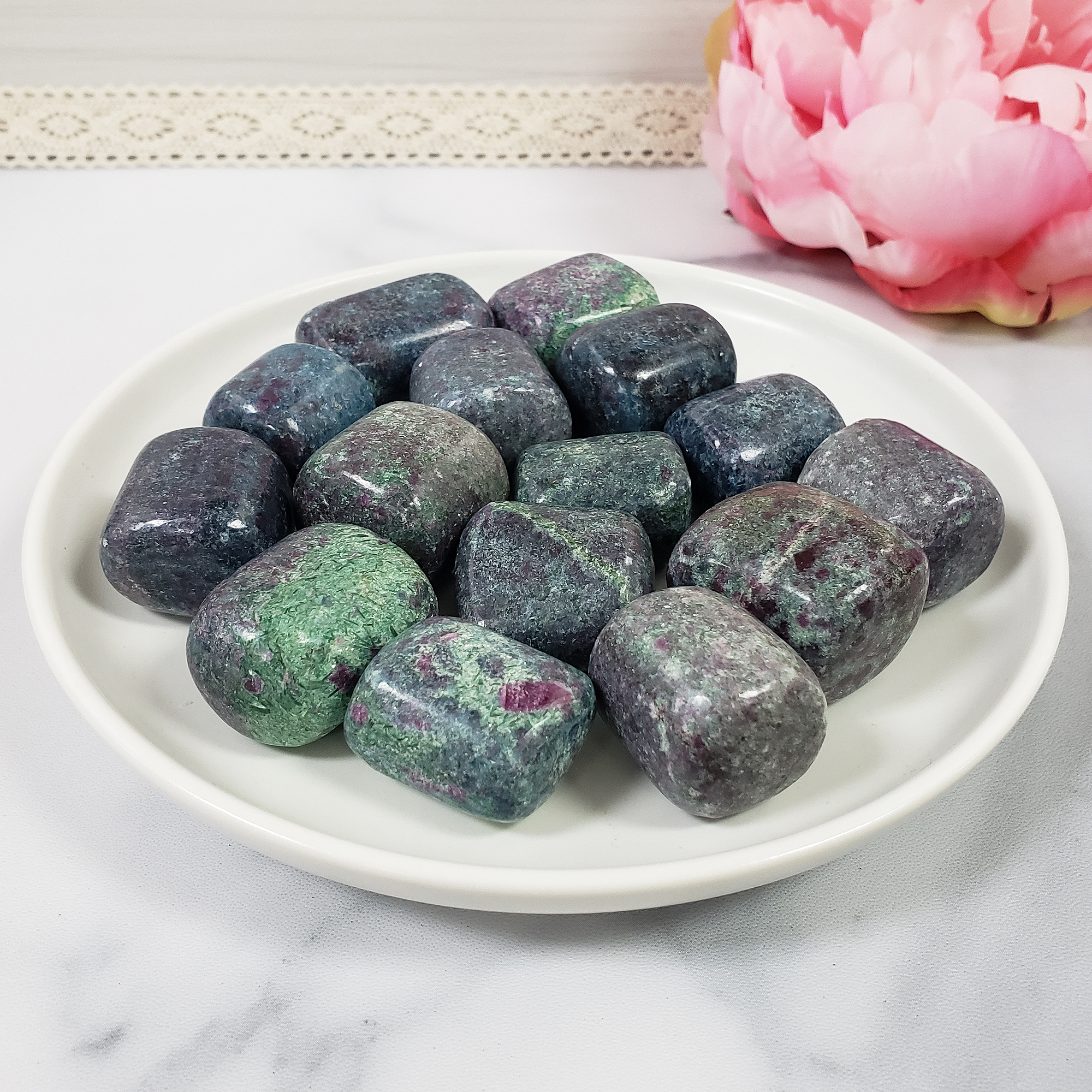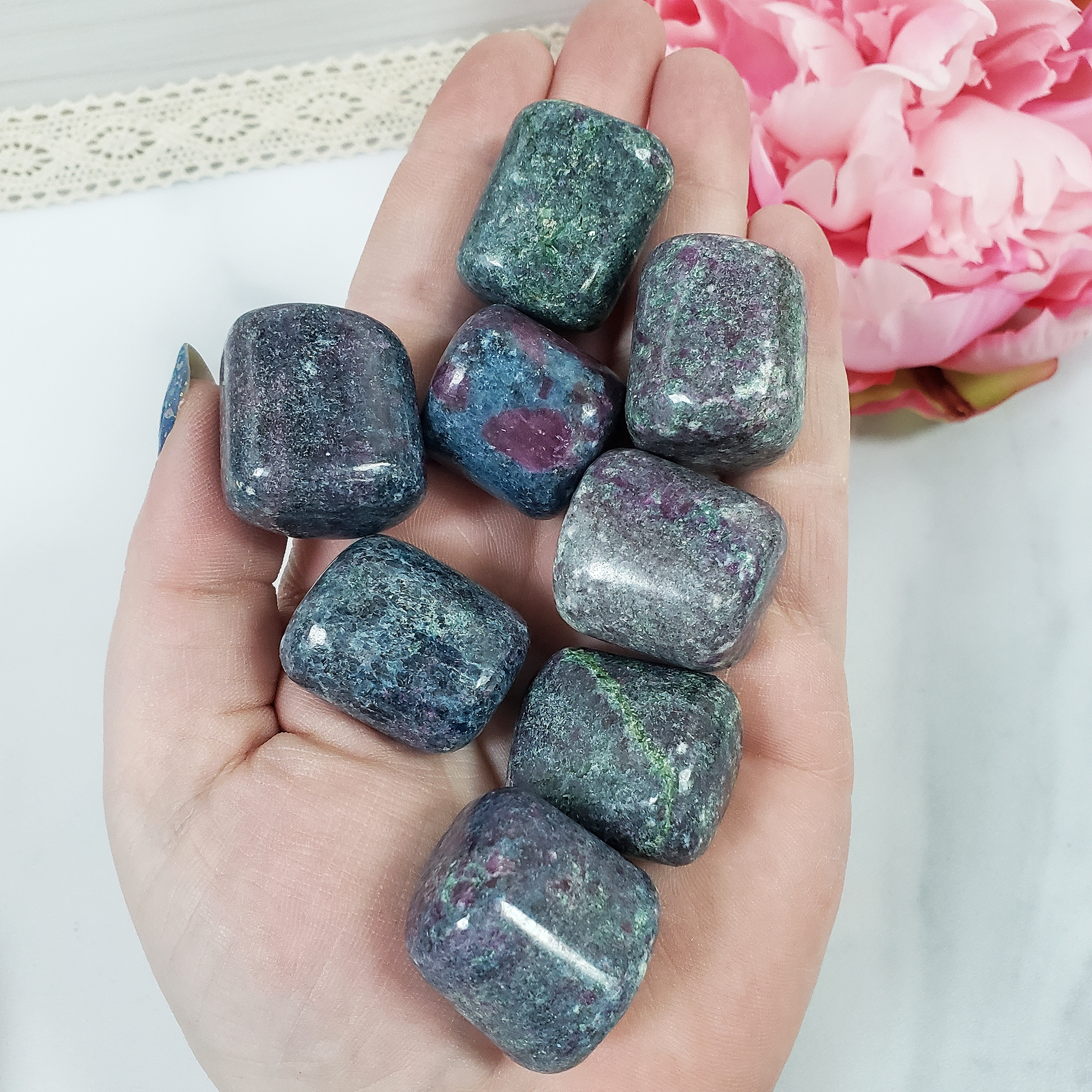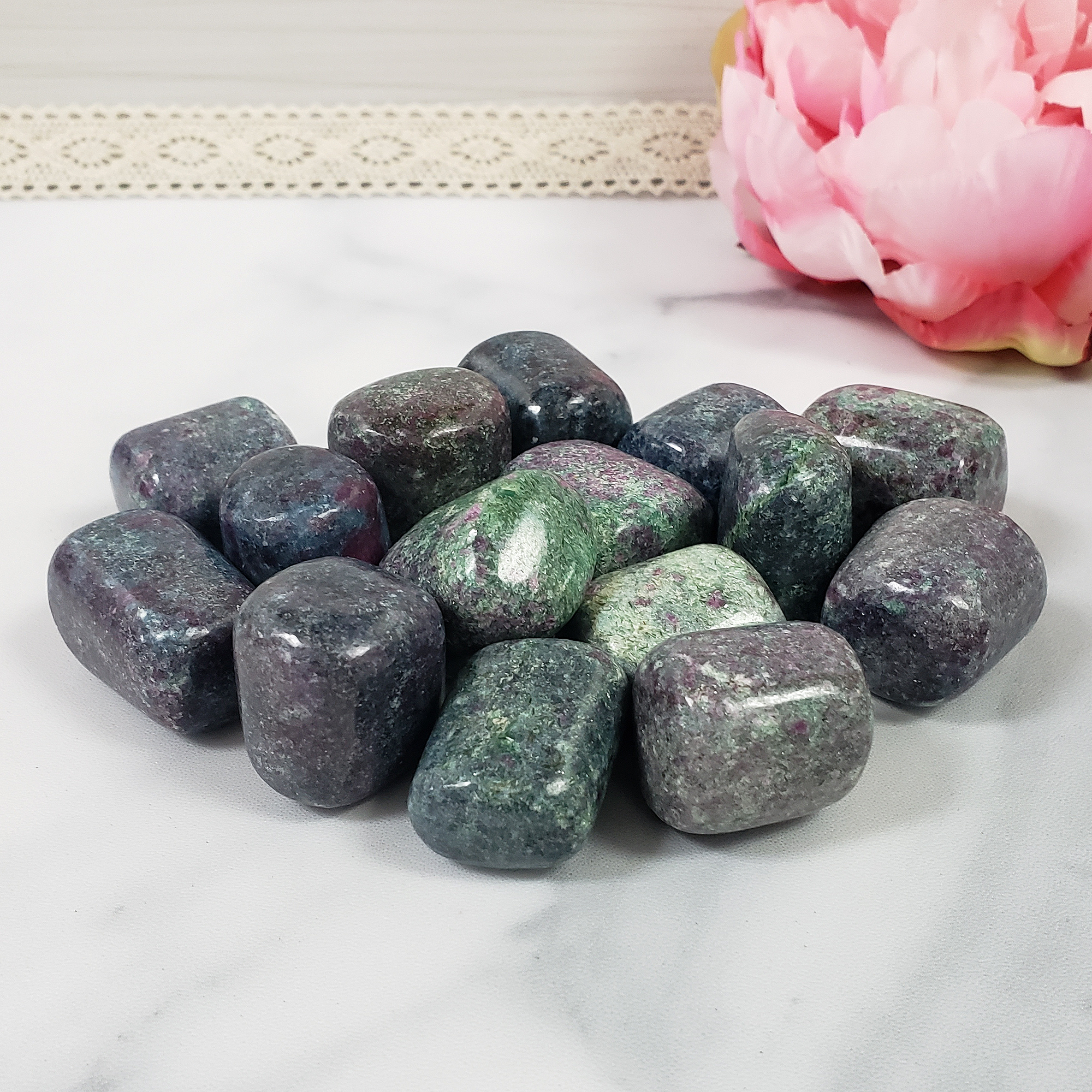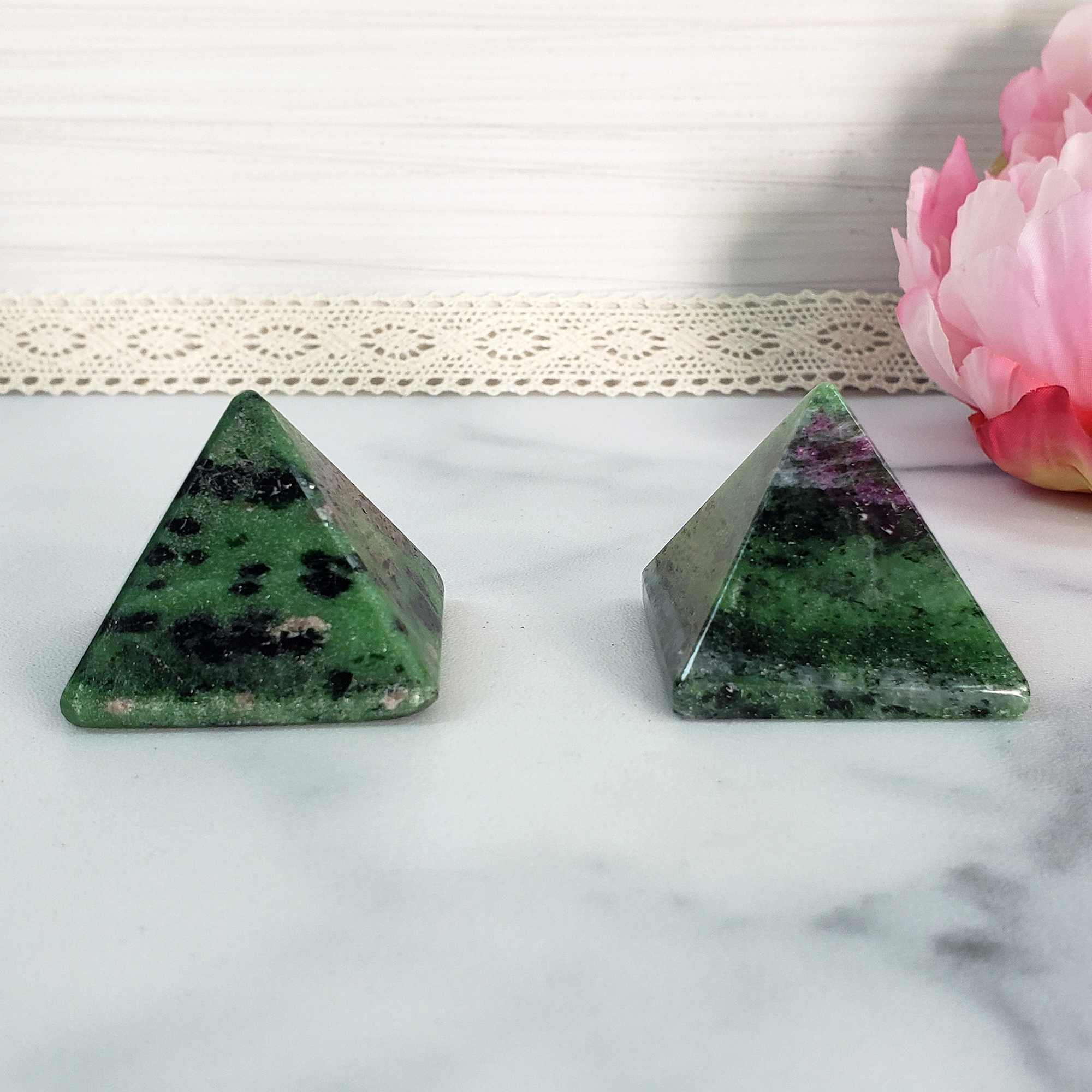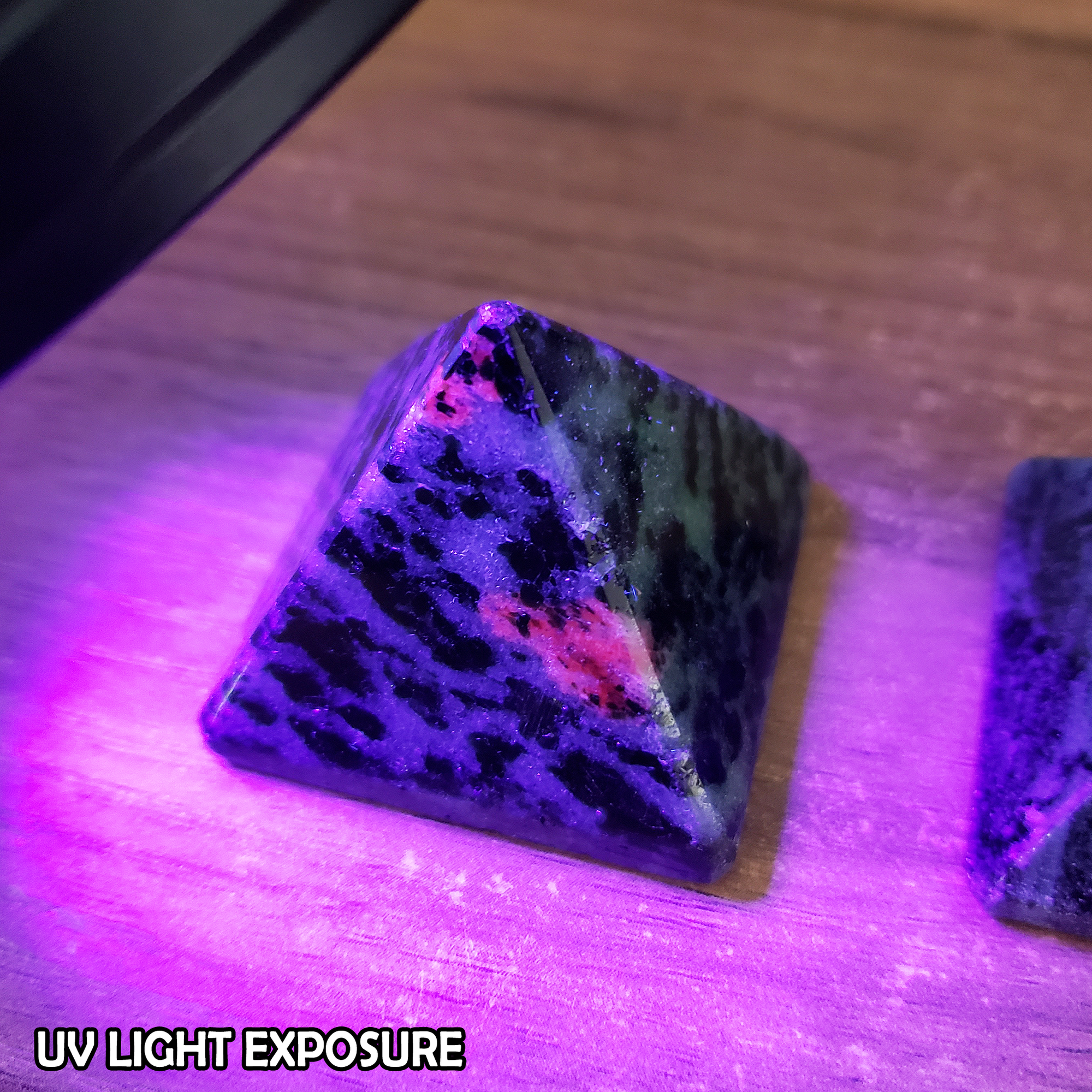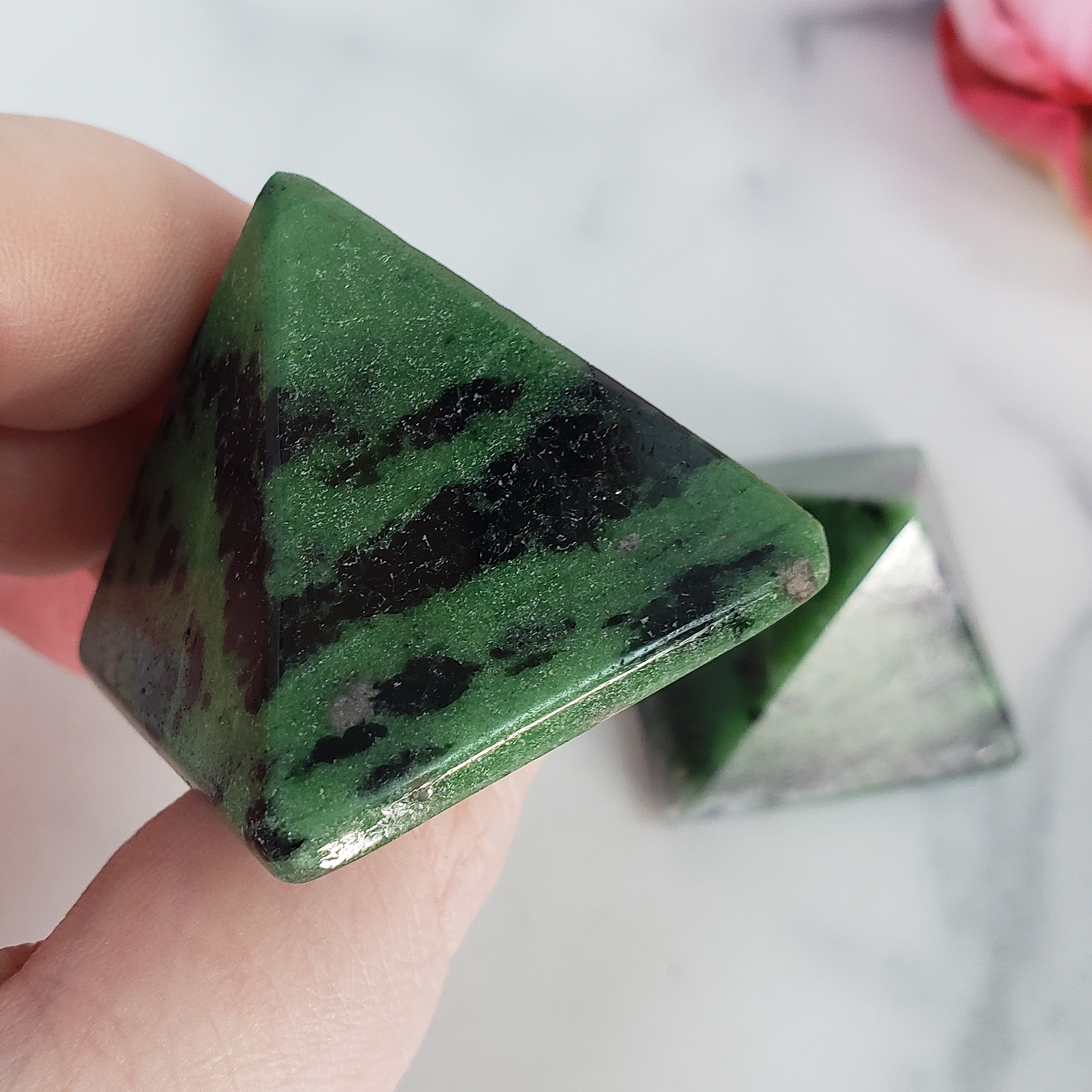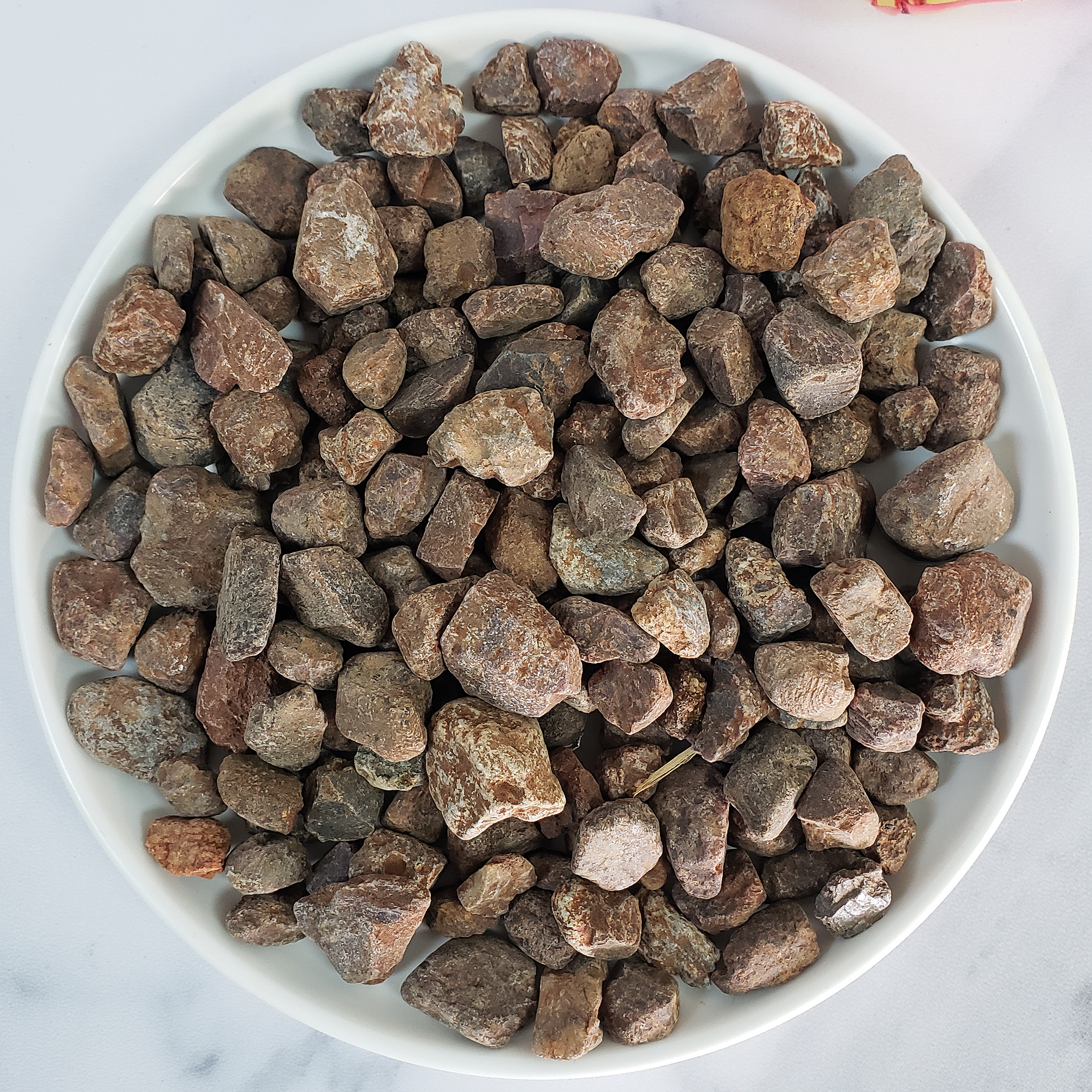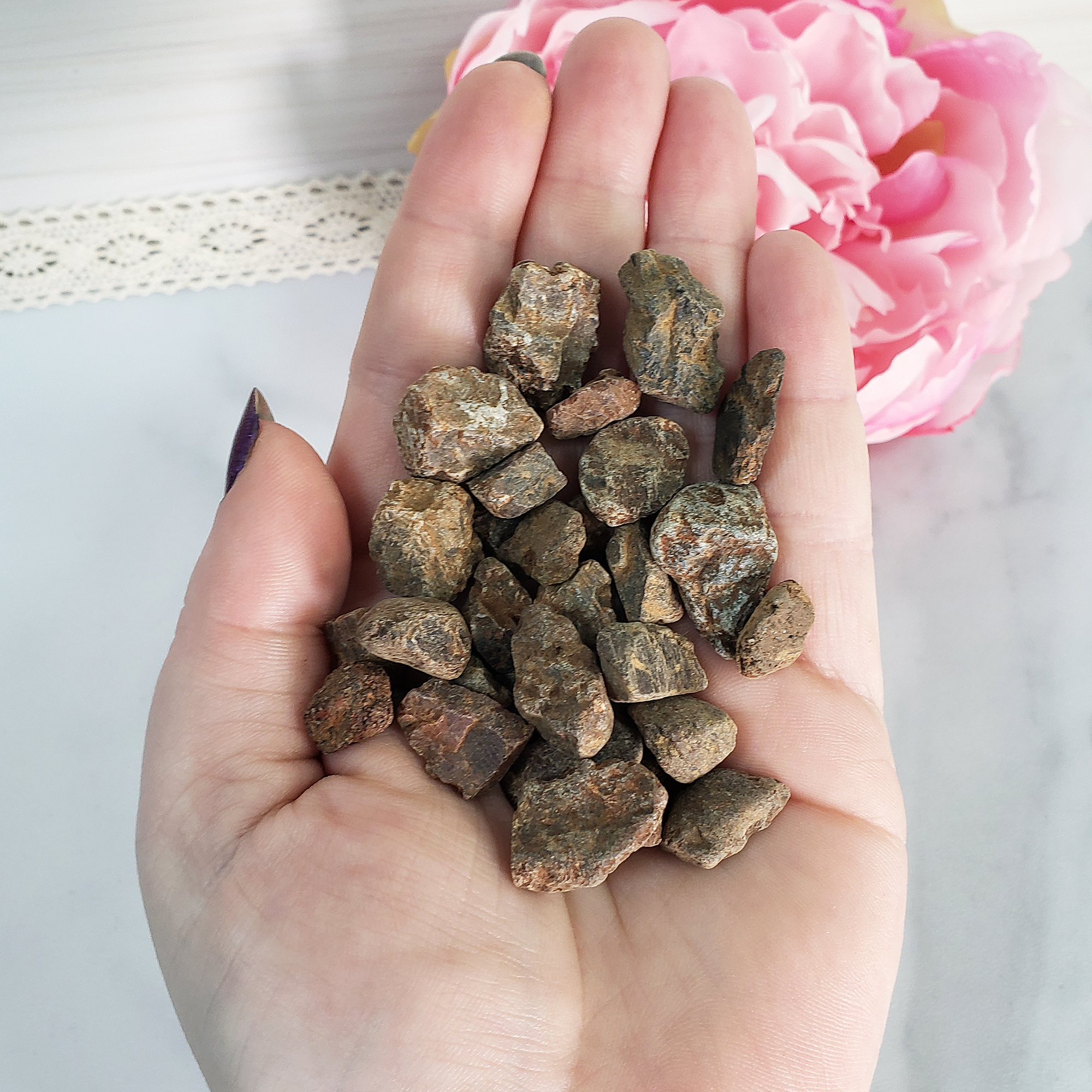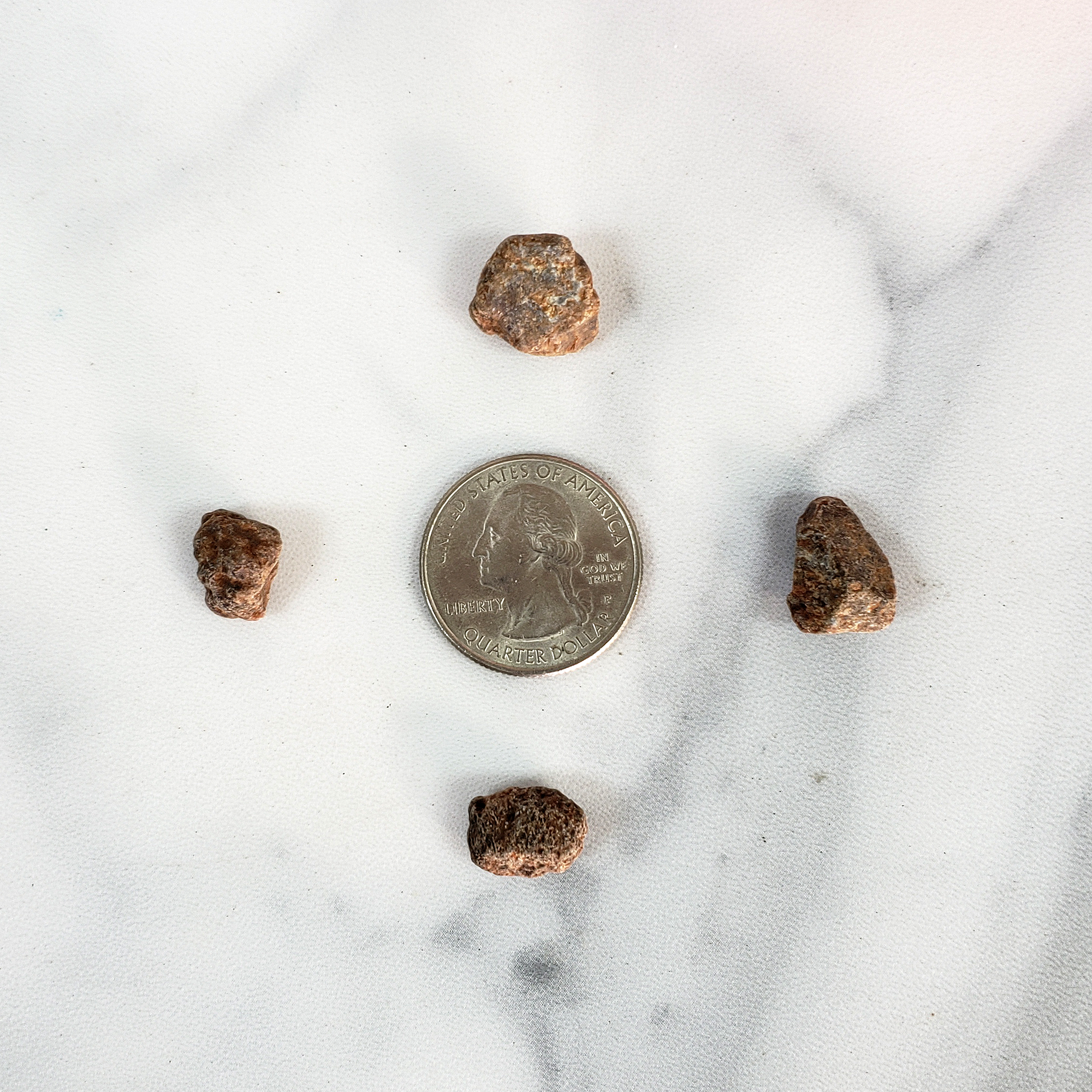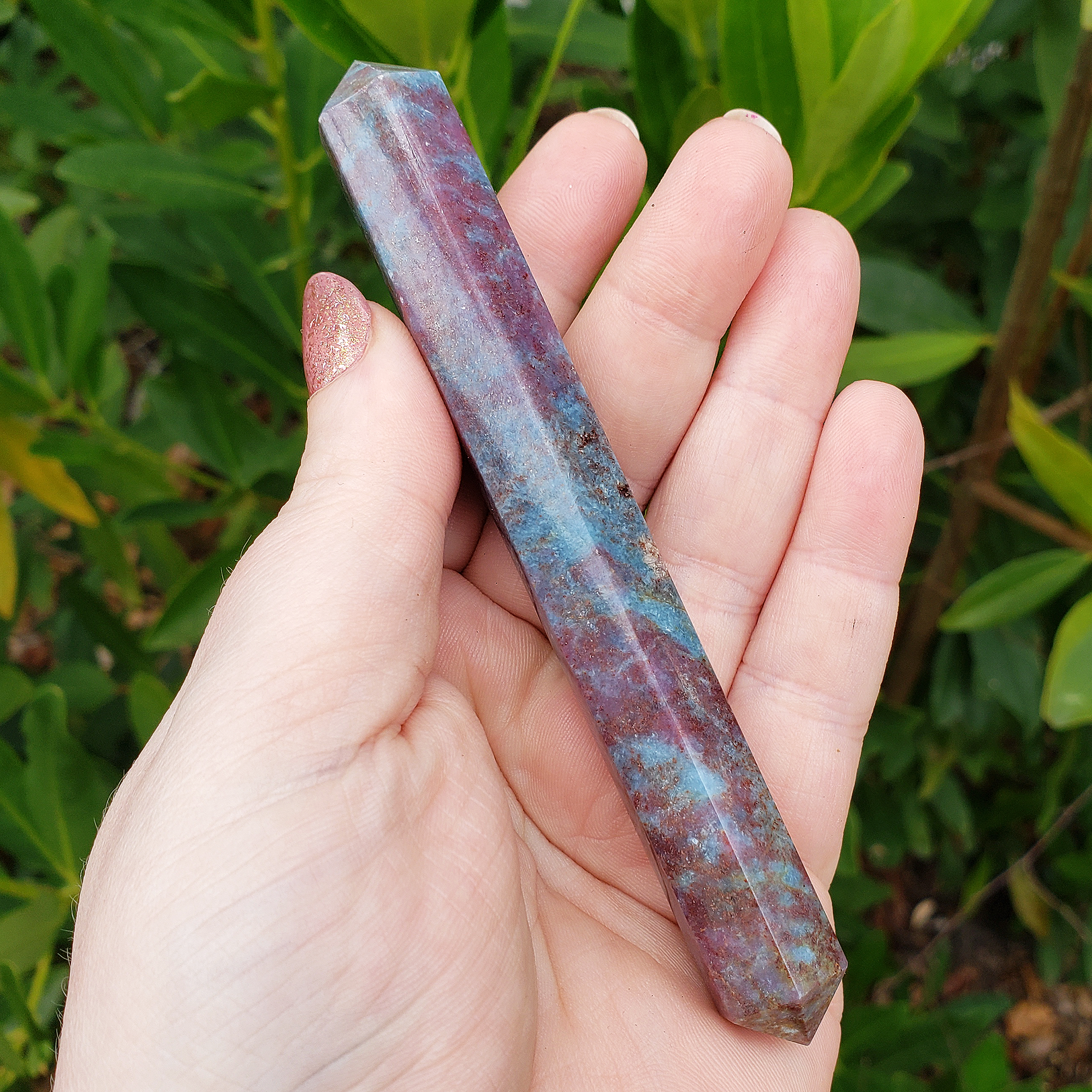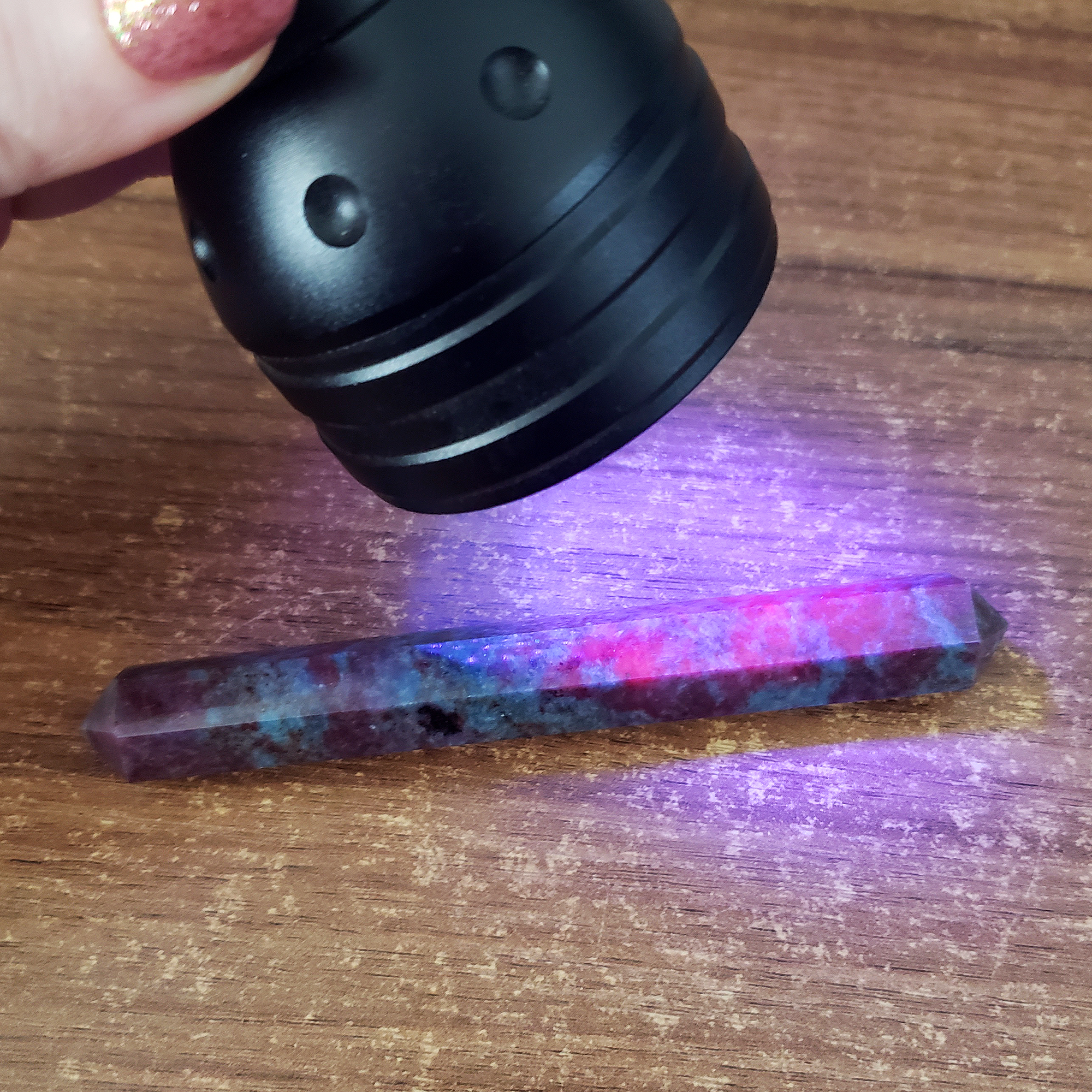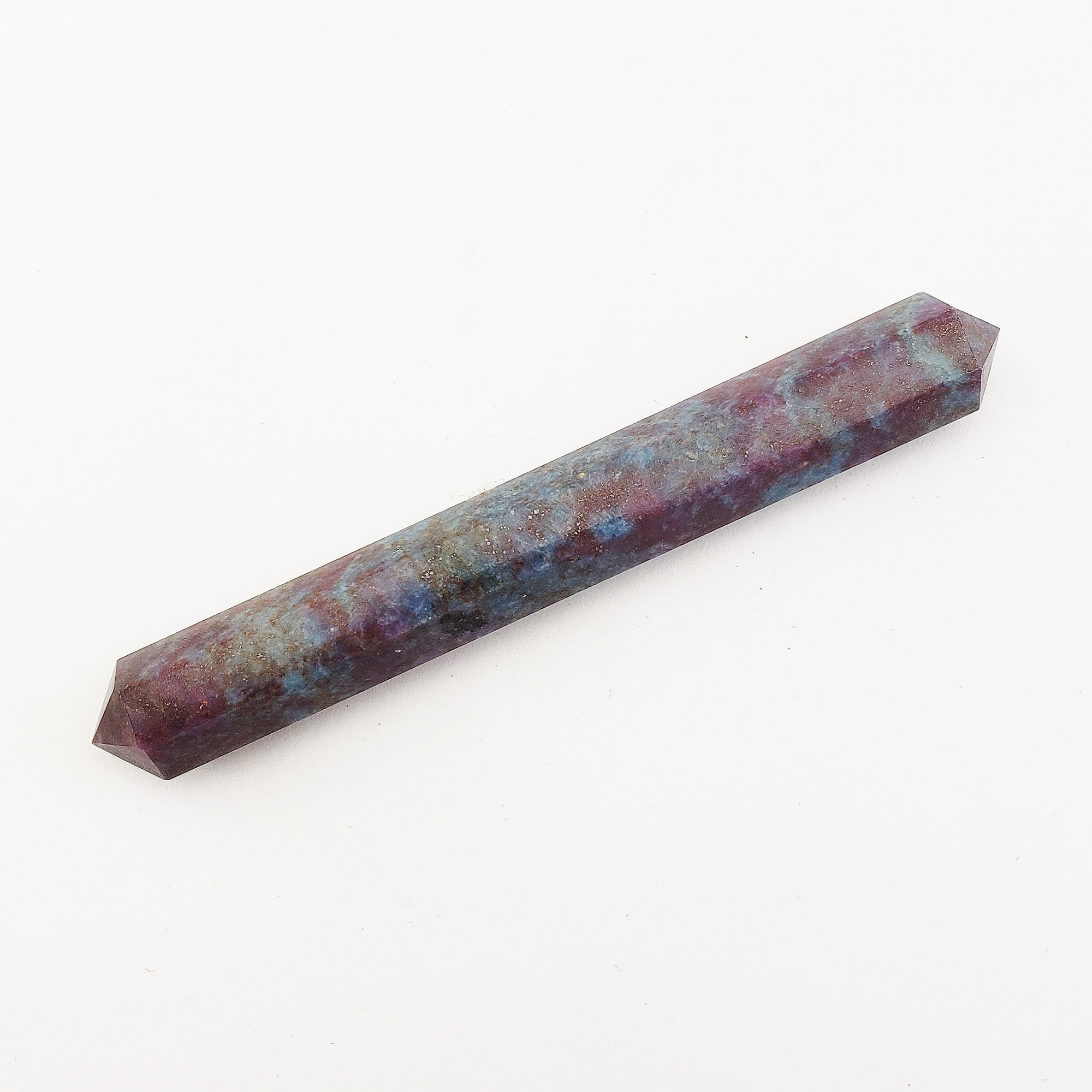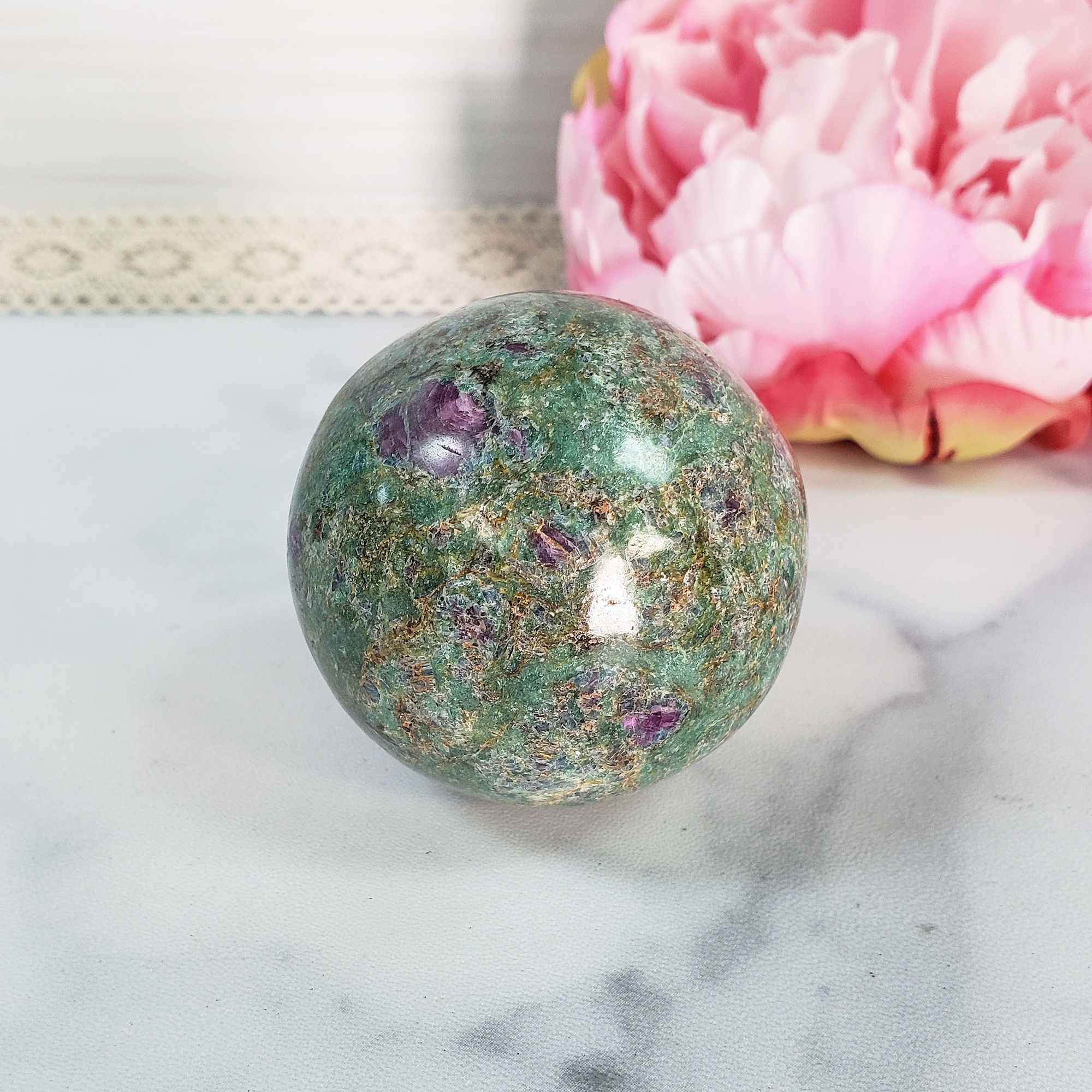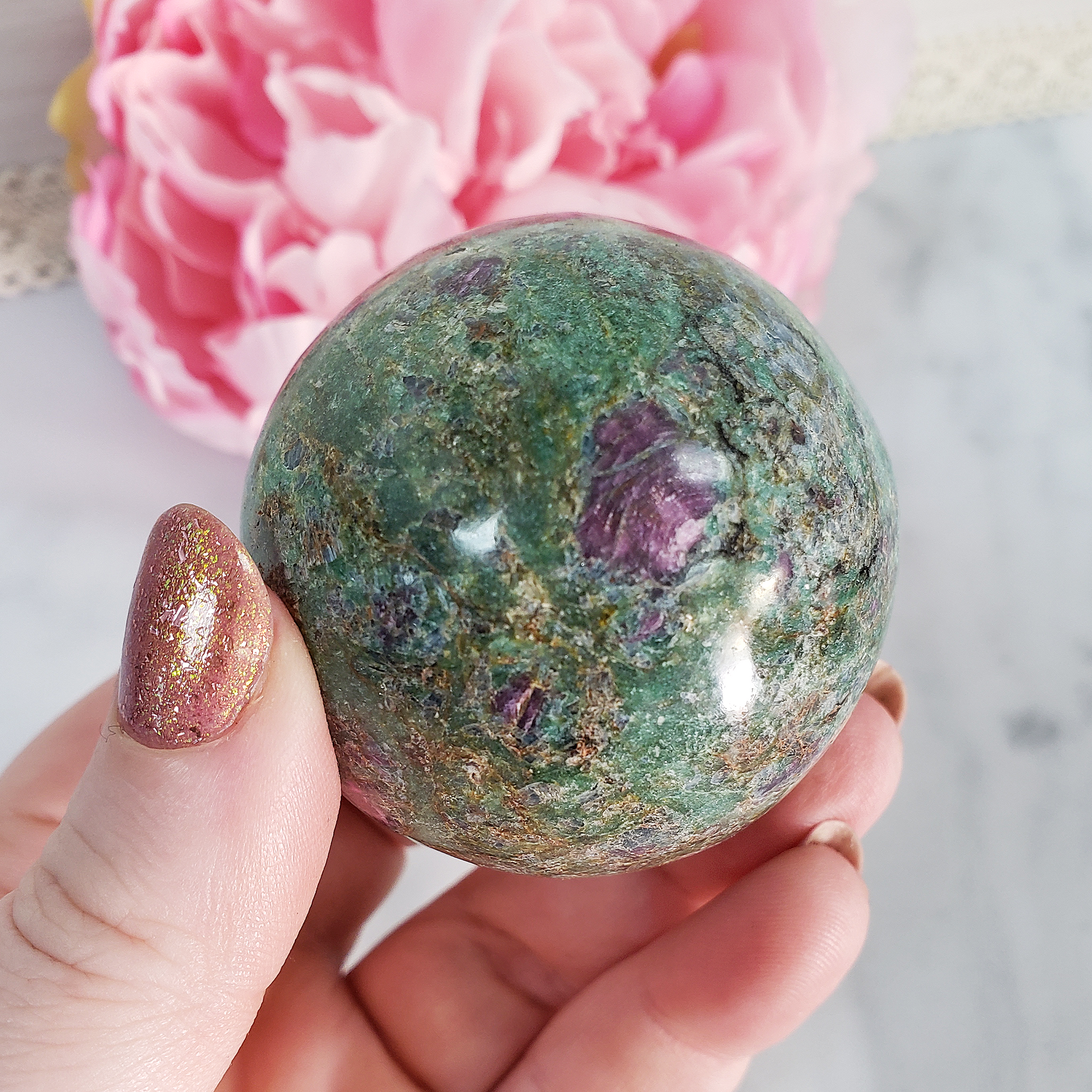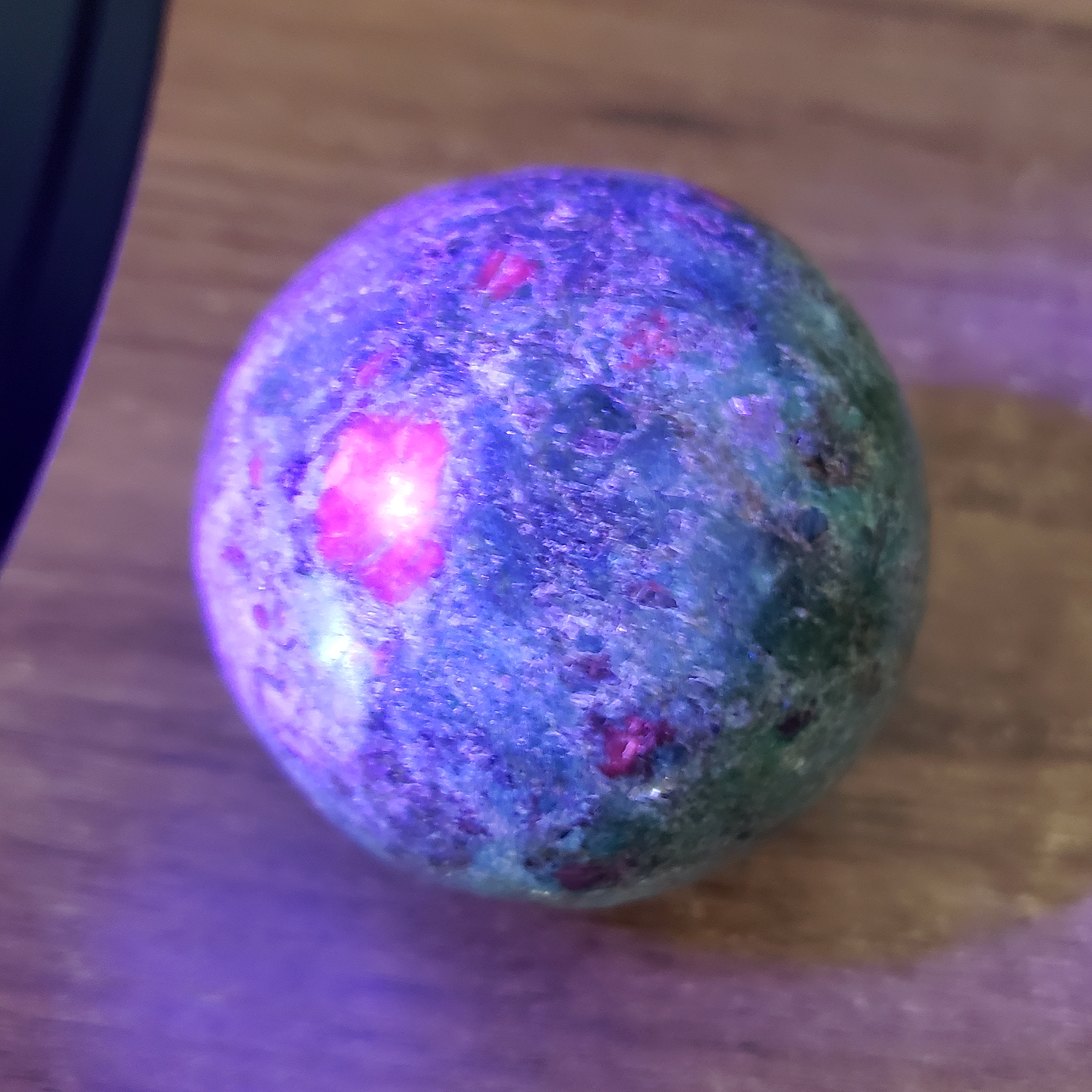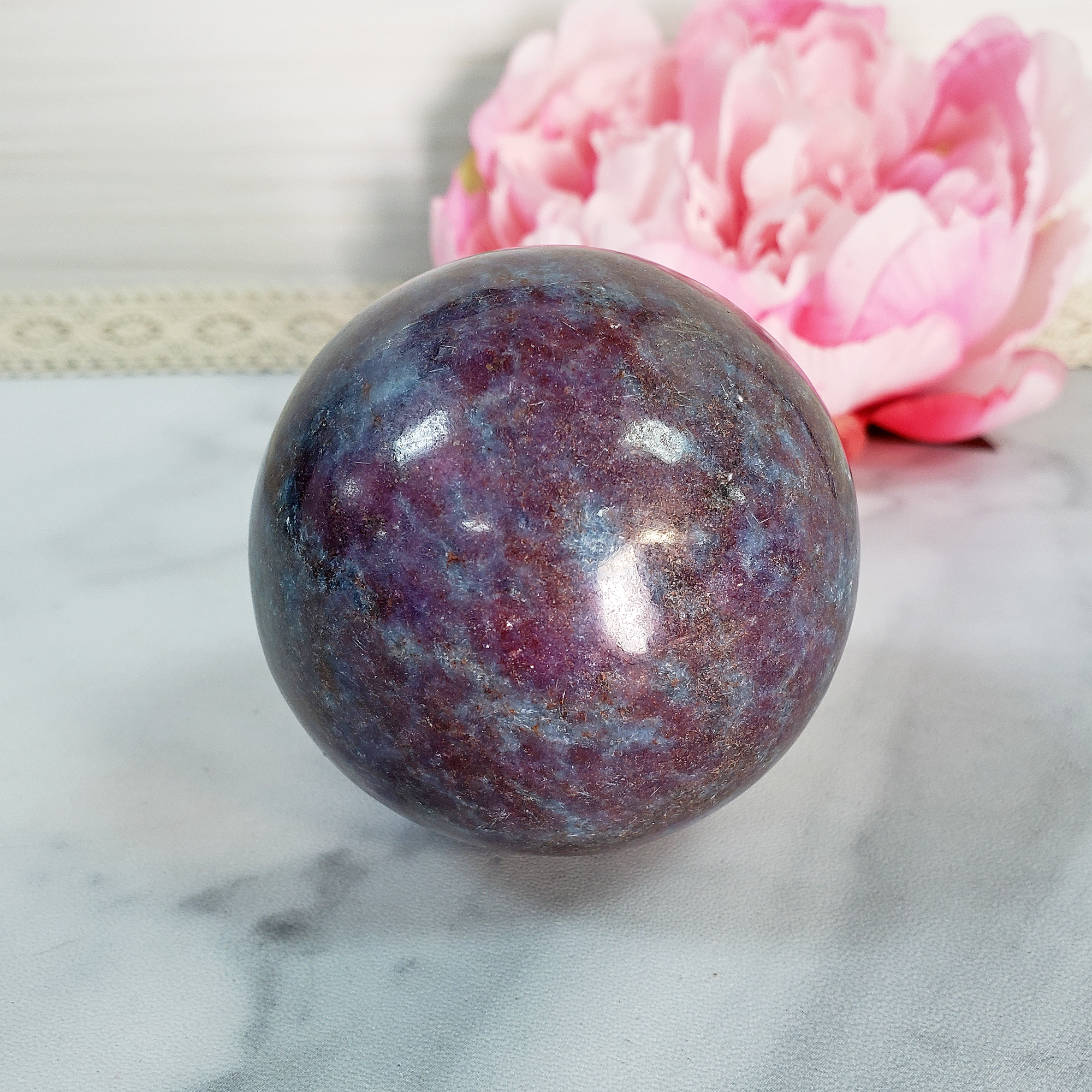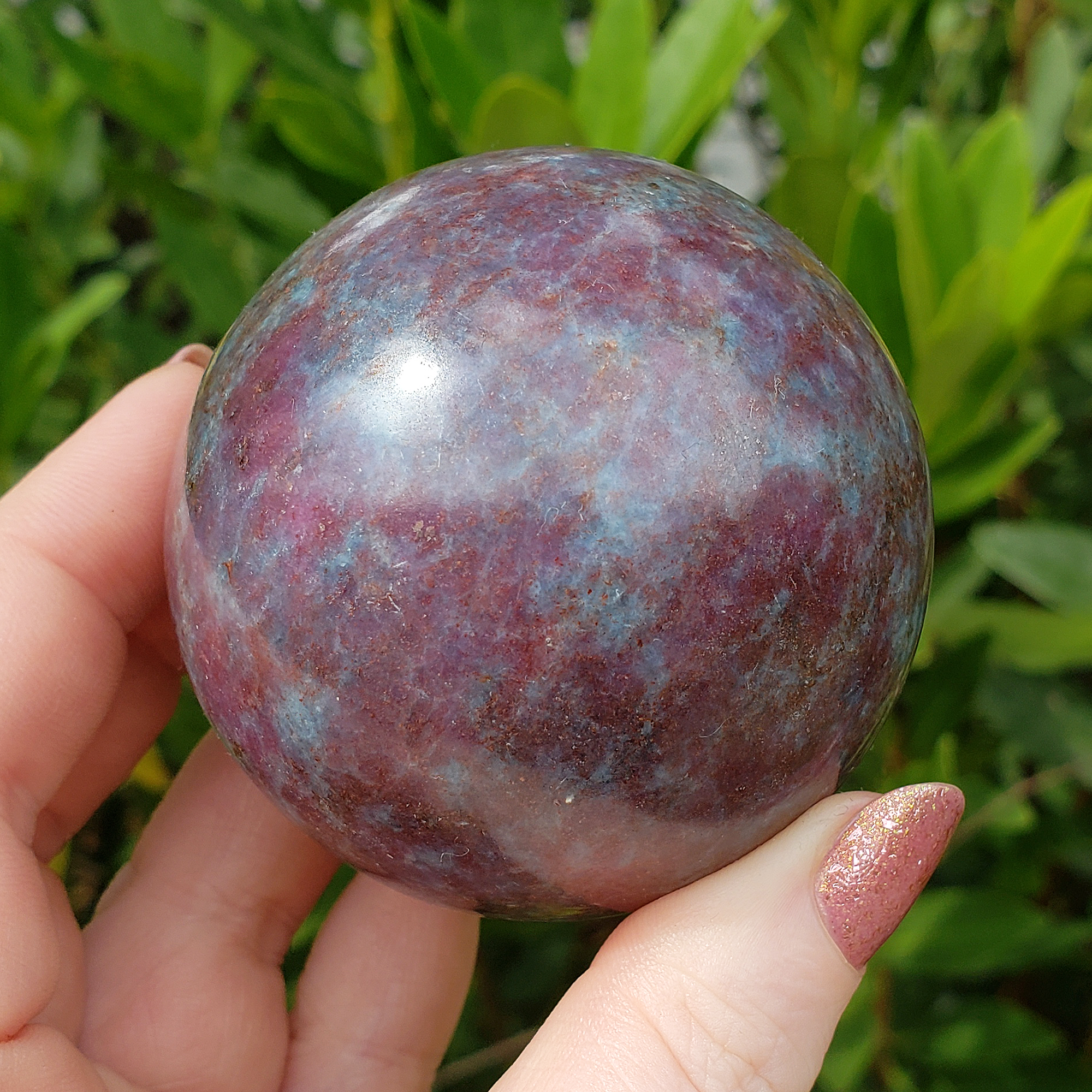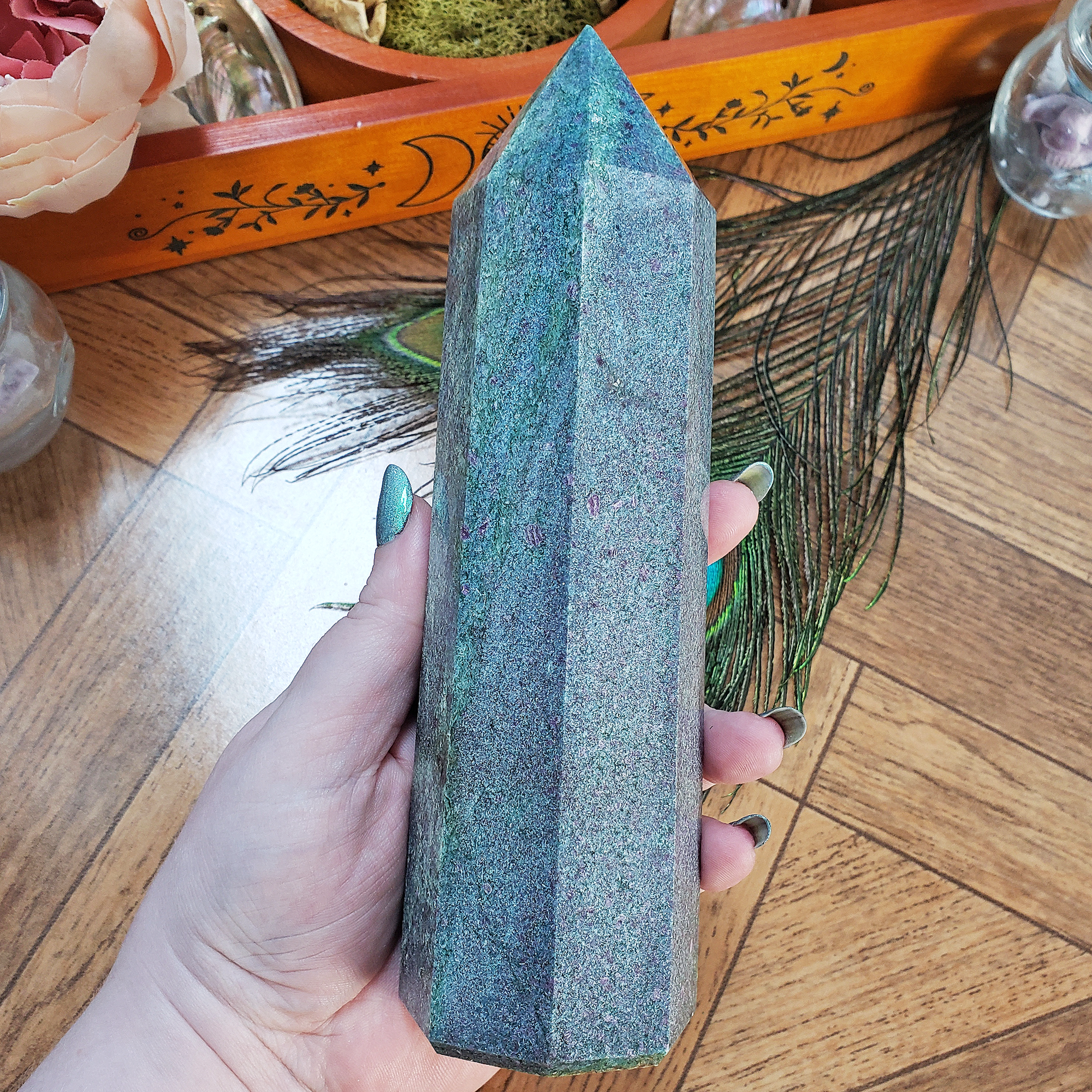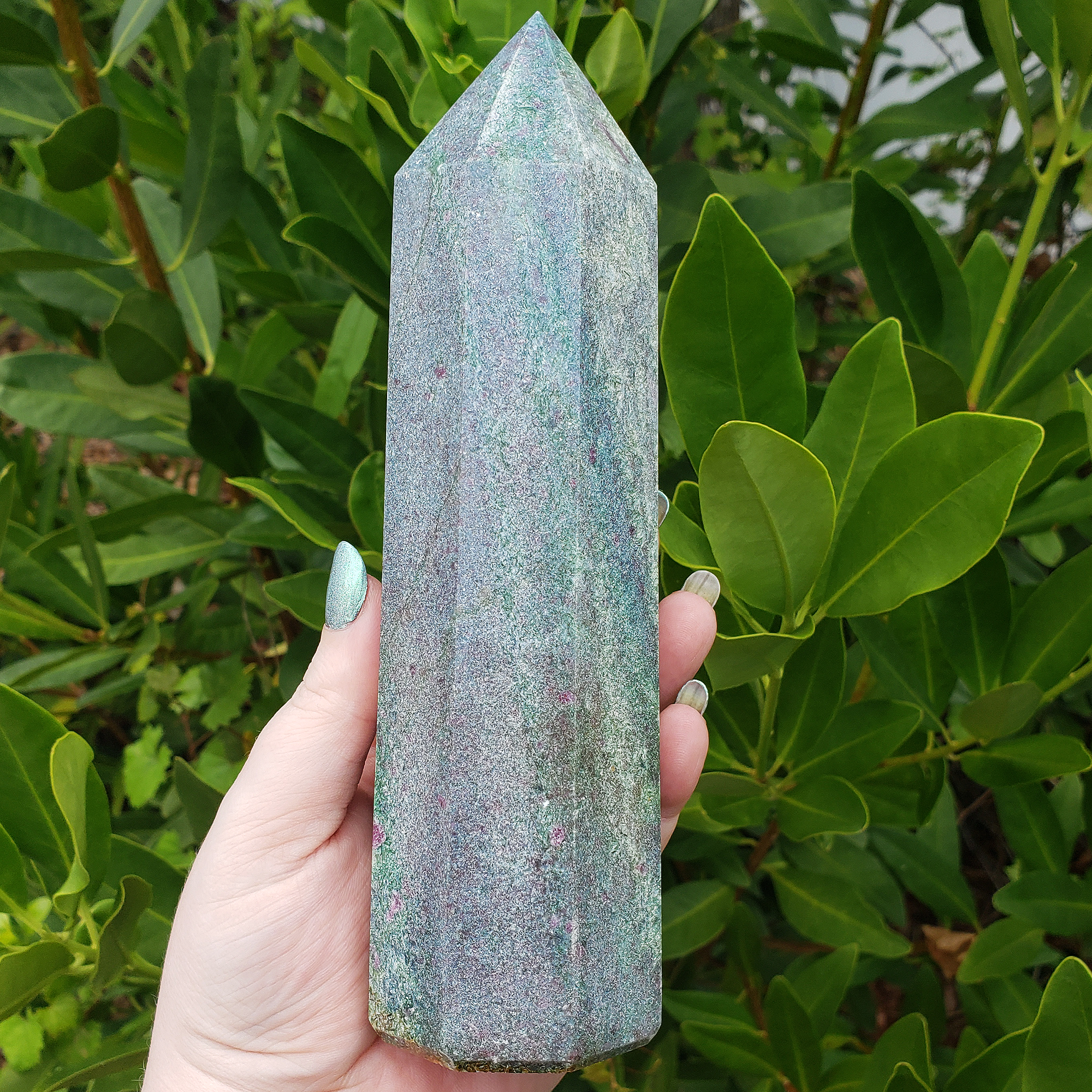Ruby is a gem of the Root Chakra and Heart Chakra, and its intense, fiery energies are known for promoting a host of blessings! Foremost, Ruby is associated with passionate devotion, both in romance and to oneself. With inward facing intent, Ruby helps us to embody courage, strength, and wisdom, helping us to overcome our fears and to achieve our goals. This aspect, in addition to the gem's luxury status, is why Ruby is used when manifesting prosperity or drawing wealth. When we turn our efforts outward, Ruby shifts that passion and drive into magnetic attraction, sensuality, and the powerful dedication of true love. With this in mind, Ruby stones are often found in engagement rings or anniversary jewelry, symbolizing the strength, affection, and success of the couple.
What Makes Ruby Red?
The vibrant red hue of a ruby is primarily due to the presence of chromium within the mineral. This element, when embedded in the crystalline structure of the gem, absorbs certain wavelengths of light and reflects back the rich red color that rubies are renowned for. The intensity of this red color can vary depending on the amount and distribution of chromium in the stone, leading to the ruby's stunning and sought-after appearance.
How to Identify a Ruby Crystal
Recognizing a ruby crystal involves observing several distinct features. Below are some key characteristics to help you identify a ruby crystal with confidence:
-
Color: Rubies are renowned for their vibrant red hue, which can range from a deep, rich red to a lighter pinkish-red. The presence of chromium gives rubies their signature color.
-
Clarity: While clarity is essential, fine inclusions in a ruby are common and do not typically affect its value. These natural imperfections are often referred to as "silk" and can indicate authenticity.
-
Cut and Shape: Rubies are fashioned into various cuts. However, they often have a hexagonal shape when in their natural crystal form. This shape can help distinguish them from other gemstones.
-
Luster: Evaluate the stone’s luster. Rubies generally have a vitreous (glass-like) to subadamantine (slightly varying) luster that adds to their allure.
-
Hardness: On the Mohs scale, rubies score a 9, making them exceptionally hard and durable. This hardness contributes to their lasting appeal and helps differentiate them from softer red stones.
By paying close attention to these characteristics, you can successfully identify a ruby crystal and appreciate its beauty and uniqueness.
Why Does a Ruby Cost So Much and Command the Highest Prices Among Colored Gemstones?
Rubies can command the highest prices among colored gemstones due to several compelling reasons. Firstly, their rarity is unparalleled. High-quality rubies, especially those with a deep red hue known as "pigeon blood," are incredibly scarce. This rarity significantly boosts their value in the market.
Furthermore, the exceptional hardness and durability of rubies add to their desirability, making them suitable for a wide range of jewelry pieces. Their rich color depth and the way they capture light make them exceedingly attractive to collectors and investors alike.
In addition, rubies have a deep-rooted historical allure. They've been revered across cultures for centuries, often associated with power and wealth. Major auction houses frequently tout record-breaking sales of fine rubies, driving consumer interest and awareness, which in turn elevates their market price.
Collectors and enthusiasts not only see rubies as beautiful pieces of art but also as valuable investment assets. This combination of rarity, beauty, historical significance, and investment potential makes rubies the most sought-after colored gemstones, capable of achieving remarkable per-carat prices.
What Makes Ruby the Gem of All Corundum?
Ruby stands out as the most prized variety of the corundum mineral species. But what sets it apart from its sapphire sibling?
The Enchanting Red Hue
The allure of ruby lies primarily in its captivating color. This gemstone boasts an extraordinary red shade, thanks to the presence of chromium. This trace element is what sets ruby's red apart from the rest of the gem world, making it truly distinctive.
The Role of Color in Determining Value
When it comes to assessing ruby's value, color plays a crucial role. The most revered rubies exhibit a pure and vibrant red, occasionally with a hint of purplish red. As the color shifts toward orangey or overly purplish tones, the gemstone's quality and value diminish.
Balancing Saturation and Tone
For a ruby to be considered top-quality, it must strike a perfect balance in color saturation—not too dark, nor too light. The vividness and consistency of the red enhance its desirability and rank on the quality scale.
In essence, the unique interplay of color, saturation, and chromium is what makes ruby the unrivaled gem in the corundum family.
How Heat Treatment Influences Ruby Value
When it comes to determining the value of a ruby, heat treatment plays a significant role.
Why Rubies are Heated
Most rubies available on the market are heat-treated. This common industry practice enhances their color and clarity, making them more visually appealing. However, this also means that natural, untreated rubies are rarer and often hold greater value.
The Premium on Untreated Rubies
Rubies that come with documentation from respected gemological laboratories, confirming they haven’t undergone heat treatment, are considered particularly rare. This rarity commands a premium price. The natural beauty and scarcity of untreated rubies make them highly sought after by collectors and connoisseurs.
Valuation of Treated versus Untreated Rubies
While heat-treated rubies are usually valued less than their untreated counterparts, they are typically more valuable than rubies that have undergone more intense treatments, such as diffusion or glass filling. These more invasive treatments can considerably lower a ruby's worth.
Key Takeaways
- Untreated Rubies: Rare, higher in value.
- Heat-Treated Rubies: Common, moderately valuable.
- Diffused or Glass-Filled Rubies: Generally less valuable.
In summary, while heat treatment enhances the appearance of a ruby, its absence in a gemstone increases the ruby’s prestige and price.
Understanding Ruby Treatments and Their Impact on Value
When you're in the market for rubies, it's crucial to understand the different treatments these gemstones might undergo and how these affect their value. Here's what you need to know:
Common Ruby Treatments
-
Heating: This is the most common treatment. Heating enhances color and clarity, making the rubies more visually appealing. Most on the market have been heated, so it’s safe to assume a ruby has undergone this treatment unless stated otherwise.
-
Diffusion: In this process, elements are added to the surface using heat to change the stone's color. While this effect can create striking colors, it is a less desirable treatment since it affects only the surface and is considered less permanent.
-
Glass Filling: This method is used to improve the appearance of rubies by filling in fractures with lead glass. While this enhances clarity, it also reduces the stone's durability and value compared to other treatments.
How These Treatments Affect Value
-
Untreated Rubies: If you come across a ruby with a certification from a reputable lab confirming no treatment, understand that these are highly valuable due to their rarity. Such rubies are often sold at a premium.
-
Heated Rubies: These still hold considerable value, especially when they are of good quality. Heating is accepted in the gemstone market, and these rubies are priced higher than diffused or glass-filled varieties.
-
Diffused and Glass-Filled Rubies: Expect these to be significantly less expensive. While they might catch the eye, their overall market value is lower due to the methods used.
Key Takeaways
- Always ask for documentation detailing any treatments a ruby has undergone.
- Consider stones that have been evaluated by independent labs to ensure you understand their true value and quality.
By equipping yourself with this knowledge, you'll be better prepared to make informed decisions when choosing a ruby that suits both your taste and budget.
The Durability of Corundum: Ruby and Sapphire Explored
When it comes to selecting gemstones for everyday jewelry, durability is a crucial factor. Corundum, which includes both ruby and sapphire, stands out due to its impressive characteristics.
Hardness
Corundum ranks high on the Mohs scale of mineral hardness, only surpassed by diamond. This means that both sapphire and ruby are highly resistant to scratching, making them ideal for pieces like rings and bracelets that encounter frequent contact.
Toughness
Beyond its hardness, corundum is notable for its toughness. This mineral can withstand the everyday impacts and pressures that jewelry often faces. Unlike more delicate gemstones that can easily break or chip, corundum offers resistance to these common damages.
Stability
Another appealing feature of corundum is its stability, especially in varied environments. Corundum maintains its color and clarity in the face of heat, light exposure, and chemicals, ensuring that your ruby or sapphire jewelry retains its beauty over time.
In summary, the combination of exceptional hardness, toughness, and stability makes corundum an excellent choice for jewelry that's worn daily. Whether you choose a vibrant ruby or a classic sapphire, you can trust these gems to stand the test of time.
How to Care for and Clean Your Ruby to Maintain Its Beauty
Rubies, celebrated for their vibrant allure, deserve proper care to keep them looking pristine. Here’s how you can ensure your ruby retains its dazzling appearance.
Understanding Ruby Durability
Crafted from corundum, rubies are both hard and durable. This makes them an excellent option for jewelry you wear daily. However, a touch of care can go a long way in preserving their beauty.
Proper Cleaning Methods
To safely clean your ruby, warm soapy water is your best friend. Simply mix a mild dish soap with warm water, then gently clean the ruby using a soft brush. Avoid harsh chemicals and ultrasonic cleaners as they can damage the stone.
Special Considerations for Treated Rubies
If your ruby has undergone treatments such as fracture-filling or dyeing, opt for a gentle approach. Use a damp, soft cloth to wipe the stone carefully, avoiding soaking it in water. Treated rubies are more delicate and require this gentle handling to prevent any harm.
By following these straightforward steps, you can ensure your ruby remains as stunning as the day you first admired it. Whether it's a cherished heirloom or a new addition to your collection, treat your ruby with care to enjoy its brilliance for years to come.
How Does the Cut Influence the Appearance and Value of a Ruby?
The cut of a ruby is paramount in determining not only its aesthetic appeal but also its market value. Here's how:
Enhancing Visual Appeal
-
Reflection and Brilliance: A well-executed cut maximizes the reflection of light within the gem. This brilliance attracts more eyes, making the ruby stand out with an incredible sparkle.
-
Symmetry and Proportion: Proper symmetry and proportion ensure that light is distributed evenly, enhancing the ruby's overall appearance. An asymmetrical or poorly proportioned cut can detract from its natural beauty.
-
Shape Versatility: Rubies are often found in a flat tabular hexagonal shape, but cutting them into various popular shapes like oval, round, or cushion highlights their unique features. While some rubies may lend themselves to elongated shapes, a skilled cutter can enhance the stone's inherent qualities.
Affecting Value
-
Appearance vs. Material: While color and clarity are natural traits, the cut is the human element that influences value. A precise cut can enhance even a less vibrant ruby, boosting its market desirability.
-
Weight Retention vs. Quality: A careful balance must be maintained between retaining as much of the original crystal as possible and achieving an optimal cut. Excessive cutting to retain weight can compromise the gem's appearance, thus affecting its value.
-
Rarity and Demand: Certain cuts are in higher demand based on current market trends. Stones cut to popular shapes and sizes are often more valuable.
In conclusion, the cut is a transformative process that can significantly improve a ruby's appearance and enhance its value, making it a crucial consideration for buyers and collectors alike.
Understanding the Differences Between Polished and Rough Ruby Crystals
When exploring the world of gemstones, particularly rubies, you'll encounter two primary forms: polished and rough. Each presents unique characteristics that cater to different preferences and uses.
Rough Ruby Crystals
-
Appearance: Rough rubies are in their natural state, often appearing raw and unrefined. They boast a rugged texture with uneven surfaces and edges, showcasing the crystal as nature intended.
-
Color and Clarity: These rubies may exhibit variations in color, ranging from deep reds to lighter hues. Due to their unprocessed nature, inclusions and imperfections are common, providing insight into their geological origins.
-
Uses: Collectors and enthusiasts cherish rough rubies for their authenticity and natural beauty. They are also popular for crafting custom jewelry where a more organic look is desired.
Polished Ruby Crystals
-
Appearance: In contrast, polished rubies have been meticulously cut and buffed to enhance their brilliance and clarity. This refining process reveals a gleaming surface, which reflects light exquisitely.
-
Color and Clarity: The cutting and polishing process amplifies a ruby’s color, providing an intense, uniform appearance. Enhancements can minimize inclusions, offering a clearer and more visually appealing gem.
-
Uses: Ideal for high-end jewelry, polished rubies are often set in rings, necklaces, and other adornments. Their sparkling allure and refined elegance make them a prestigious choice for luxury markets.
Key Differences
- Texture: Rough rubies have a natural, uneven texture, whereas polished rubies boast a smooth, glossy finish.
- Aesthetic Appeal: While rough rubies appeal to those who appreciate raw beauty, polished rubies draw attention for their refined sparkle.
- Purpose: Consider your purpose—whether it's for a collector’s item, organic jewelry, or fine crafted pieces—when choosing between rough and polished rubies.
Understanding these differences will help you make an informed decision, whether you're a collector seeking raw gems or a jewelry enthusiast in search of polished elegance.
Understanding the Role of Lab Reports in Evaluating Ruby Quality and Treatment
When it comes to purchasing rubies for making jewelry, knowing their authenticity and quality is essential. Here’s where an independent lab report becomes invaluable.
Authenticity Verification
Lab reports from reputable, third-party laboratories confirm whether a ruby is natural or synthetic. This certification assures you that the gemstone in question is genuinely from the earth and not artificially made.
Detection of Treatments
Rubies often undergo various treatments to enhance their appearance. A lab report provides detailed insights into any treatments applied, such as heat or chemical processes. This transparency ensures you are fully informed about the stone's true nature.
Quality Assessment
Beyond authenticity and treatment detection, these reports offer a high-level quality assessment. Factors such as color, clarity, and carat weight are meticulously analyzed, providing a comprehensive picture of the ruby's overall quality.
Comprehensive Evaluation
While these reports do not typically assign grades, they evaluate a ruby's characteristics, including weight, measurements, shape, cutting style, and color. This evaluation can also include an opinion on the ruby's geographic origin if requested. Understanding these details equips you with valuable information about your gemstone.
Buyer Confidence
Armed with this information, you can make more confident purchasing decisions. Knowing that an expert has thoroughly examined the ruby offers peace of mind and assurance of your investment.
In summary, independent lab reports are crucial in the gemstone buying process, revealing essential information about a ruby’s authenticity, treatment, and quality. These detailed evaluations ensure that you have all the necessary insights to make an informed decision.
How to Verify the Information on a Ruby Report
If you have a ruby that comes with certification from a reputable place like GIA, you can access the information from the report with the certifying company. Ensuring the authenticity and accuracy of a ruby report is crucial when buying or selling gemstones. Here's a streamlined guide to help you verify the information:
-
Access the Report Database: Begin by visiting a trustworthy online database that specializes in gemstone reports. Many gemological institutes offer such services where you can access their database online.
-
Locate the Report Number: Every gemstone report should have a unique identification number. Locate this number on your report.
-
Enter Details in the Database: Input the report number and any other required details, such as the date of the report or specific gemstone characteristics, into the database search function.
-
Compare the Information: Once you have accessed the corresponding data, meticulously compare every detail—from color and cut to weight and clarity—against what’s listed on the online report.
-
Check for Consistency: Pay close attention to any discrepancies. Ensure all details, including minor notations, align with what's on the official report.
-
Use a Trusted Gemologist: If you’re uncertain, consult with a certified gemologist who can provide professional insight and verify the report's claims independently.
By following these steps, you can confidently assess the reliability of a ruby report and make informed decisions.
Does the Origin of a Ruby Guarantee Its Quality?
When considering the quality of a ruby, it's common to wonder if its origin plays a pivotal role. However, the locale where a ruby is mined doesn't necessarily determine its worth or grade.
Variability Across Locations
- Even the best mining regions can yield a mix of high and low-quality rubies.
- While certain areas like Myanmar (formerly Burma) or Mozambique are renowned for producing exceptional rubies, other regions can also deliver stones of comparable quality.
Quality Over Origin
-
Color and Clarity: These are the primary factors that assess a ruby’s quality, rather than where it is sourced. A rich, vibrant color and minimal inclusions greatly enhance a ruby's value.
-
Cut and Carat: Skilled cutting can augment a ruby’s appearance, and larger carats that retain high color and clarity are particularly valuable.
-
Treatment: Many rubies undergo treatments to enhance their color or clarity, impacting their final quality and price more than their origin might.
Conclusion
Ultimately, while some locations have reputations for high-quality rubies, it's essential to evaluate each stone individually. Factors like color, clarity, cut, and treatment take precedence over origin in determining a ruby's true quality and value.
What is a "Created" Ruby Found in Jewelry?
A "created" ruby, also known as a laboratory-grown ruby, is a gemstone that is made in a controlled laboratory environment. These rubies are crafted using advanced technology that replicates the natural processes occurring underground over millions of years, albeit in a significantly shorter period.
Unlike natural rubies, which are formed in the earth's crust, "created" rubies are produced by companies using various synthetic methods. The Federal Trade Commission allows these gemstones to be described with terms like "laboratory-grown," "laboratory-created," or appended with a company's name followed by "created."
Here's what you need to know about created rubies:
- Appearance: They possess the same chemical composition and physical properties as natural rubies.
- Cost: Generally, these rubies are more affordable than their natural counterparts.
- Sustainability: Producing laboratory-grown rubies has less environmental impact compared to traditional mining.
In summary, "created" rubies provide an accessible, eco-friendly alternative to natural gemstones, while maintaining similar aesthetic and physical qualities.
Understanding the Significance of Carat Weight in Rubies
Carat weight plays a crucial role in determining the value and appeal of rubies. While small rubies are found easily and in abundance, high-quality rubies that tip the scale beyond one carat are exceedingly rare and highly coveted. This rarity inherently boosts their price and prestige.
Why Size Matters
-
Rarity and Value: Exceptional rubies, especially those weighing over a carat, are scarce. This scarcity leads to a higher cost per carat, making these larger stones more valuable and sought after by collectors and connoisseurs.
-
Market Availability: While larger, fine-quality rubies are uncommon, you can find commercial-grade rubies in various sizes quite readily. This range gives buyers flexibility in selecting rubies that fit their budget and desired size.
Impact on Investment
When purchasing a ruby, the carat weight directly impacts its investment potential. A larger, top-grade ruby not only demands a premium price today but has the potential to appreciate significantly over time, given its rarity and desirability.
In essence, carat weight in rubies does more than just indicate size; it significantly influences the stone’s value, rarity, and investment appeal.
Understanding Ruby Inclusions and Their Impact on Value
Why Are Inclusions Expected in Rubies?
In the fascinating world of gemstones, rubies are almost always expected to contain inclusions. This is because finding a completely inclusion-free ruby is an exceptionally rare occurrence. Inclusions are essentially natural imperfections within the stone that form as the ruby develops in the earth.
These blemishes or internal characteristics are part of what makes each ruby unique, much like the fingerprints of a person. Inclusions in rubies are so commonplace that their presence is typically anticipated by gemologists and traders alike.
How Do Inclusions Impact Ruby Value?
The value of a ruby is significantly influenced by the type and visibility of its inclusions. Here’s how inclusions can affect a ruby's worth:
-
Visibility: Subtle or less obvious inclusions have a minor impact on value, as they do not detract significantly from the stone’s overall beauty.
-
Location and Size: Inclusions that are prominently visible or those that diminish the ruby's transparency and brightness can lead to a considerable decrease in value.
-
Overall Effect on Appearance: The most prized rubies are those where inclusions are minimal and have little effect on the gem's radiance and clarity. Hence, a stone with more apparent inclusions is less likely to command a high price.
The allure of rubies is often balanced between their rich, vivid color and the presence of any inclusions. Ultimately, while inclusions are expected, their specific characteristics play a critical role in determining the beauty and market value of each stone.
Essential Factors to Consider When Buying a Ruby
Understanding Color Importance
The color of a ruby is its most defining feature. In fact, color is the most important quality factor for these precious gemstones. The highest-quality rubies radiate a vibrant red or sometimes a slightly purplish-red hue.
As the color becomes too orangy or more purplish, the ruby's quality diminishes. Look for rubies with vivid color saturation that is neither too dark nor too light. These will typically be considered the finest quality.
The ideal ruby showcases a perfect balance, ensuring its color is both captivating and even. This attention to detail in color can significantly impact the stone's value and desirability.
Evaluate Clarity
Inclusions, or natural imperfections, are expected in most rubies since flawless ones are exceedingly rare. The visibility and impact of these inclusions on the ruby’s clarity significantly influence its value. Noticeable inclusions or those that affect the gem’s transparency and brightness can cause a substantial drop in price.
Importance of the Cut
A well-executed cut can enhance a ruby's appearance significantly. The crystal shape of a ruby dictates the best cutting style. Most commonly, rubies are found in a flat tabular hexagonal shape, although variations may exist based on the source. The cut affects the ruby's brilliance and how it interacts with light.
Considering Carat Weight
The size of a ruby, measured in carats, also plays a crucial role in its valuation. High-quality rubies over one carat are scarce, thus considerably more valuable. As the size increases, so does the price per carat, especially for fine-quality stones.
Mixed Cuts
A mixed cut in rubies combines elements from different cutting styles to enhance the stone's natural beauty, sparkle, and color. This technique often involves shaping the top of the ruby with a brilliant cut, characterized by multiple small facets, which maximizes the gem's luster and light reflection. The bottom, or pavilion, is typically cut in a step fashion, featuring larger, tiered facets that emphasize the gem's depth and color saturation. This combination aims to optimize both the visual appeal and inherent qualities of the ruby, making it a favored choice among jewelers and collectors looking for a harmonious blend of brilliance and richness.
Tips & Advice for Buying Rubies
-
Choose a Trusted Jeweler
Seek out a jeweler with expertise in gemstones. A professional with gemological credentials can demonstrate different quality samples, allowing for an informed comparison. -
Separate Origin from Quality
Don’t confuse a ruby's place of origin with its quality. Even renowned mines produce low-quality stones. Fine rubies can be sourced from various locations worldwide, so focus on the gem's individual merits rather than its geographic origin. -
Inquire About Treatments
Many rubies undergo treatments to enhance their appearance, such as heating, surface color diffusion, or filling fractures with materials like lead glass. Always ask for written verification of any treatments the ruby might have undergone. -
Consider Professional Evaluation
When in doubt, request an evaluation from an independent laboratory. Certified reports can authenticate the ruby’s natural status and detail any treatments it may have received.
With these insights, you'll be well-prepared to make an informed decision when selecting a ruby.
The Importance of Choosing a Trusted Jeweler for Ruby Purchases
When investing in a ruby, partnering with a reputable jeweler is essential. Rubies are complex gemstones, each with its unique qualities, making it crucial to rely on expert guidance.
Expertise Matters
-
Understanding Quality: Not all rubies are created equal. A skilled jeweler can explain the subtle variations in color, clarity, and cut, which can significantly affect the stone's value.
-
Credentials: Reputable jewelers often hold gemological certifications. These credentials demonstrate their deep understanding of gemstones, ensuring you receive accurate information.
-
Comparison Opportunity: Trusted jewelers can provide an array of certified rubies. Viewing multiple stones side by side allows you to appreciate the differences, helping you make an informed decision.
Assurance and Trust
-
Authenticity: Counterfeit stones can deceive even a keen eye. A respected jeweler offers assurance of authenticity, often with certified documentation that verifies the ruby's origin and quality.
-
Ethical Sourcing: Buying from a trusted source also means you are more likely to purchase ethically sourced gems, supporting fair practices throughout the supply chain.
Investment Protection
- Value for Money: With significant financial investments, ensuring the ruby’s legitimacy and quality is crucial. Expert jewelers help protect your investment by offering gems that meet industry standards.
In summary, a trusted jeweler provides clarity, expertise, and peace of mind, turning the purchase of a ruby into a confident and informed experience.
How Does the Origin in Marble Affect Ruby Crystals?
Ruby crystals that form within marble possess unique characteristics that influence their appearance and value. The marble's composition provides a white calcite matrix, which is a key factor in the development of these gemstones.
-
Enhanced Color and Clarity: Rubies from marble deposits typically showcase a vivid red hue known for its saturated and vibrant appearance. This is largely due to the low iron content in marble, which prevents the rubies from developing darker tones.
-
Superior Brightness: The rubies' close contact with the calcium-rich environment of marble enhances their brilliance. The low iron content also contributes to creating rubies with exceptional brightness and a distinct glow, often referred to as "pigeon's blood" red in premium stones.
-
Rarity and Value: Marble-hosted rubies are generally considered rarer than those originating from other geological settings. This rarity often translates to higher market value, especially when the stones are free from significant inclusions.
-
Distinctive Inclusions: The unique geological environment can lead to the presence of specific types of inclusions within the stones, which can be used to pinpoint their origin during gemological analysis.
The birth of a ruby within marble imparts these distinct qualities, making them highly sought after in the jewelry market for their unparalleled color and brightness.
The Significance of the Mogok Deposit in Myanmar for Rubies
The Source of the World's Finest Rubies
The Mogok region in Myanmar holds a legendary status among gem enthusiasts for producing some of the world's finest rubies. This area has been celebrated for centuries, and connoisseurs often find that rubies from Mogok convey an unmatched quality and allure.
Unique Geological Composition
What sets the Mogok deposit apart is its distinctive geological composition. Rich in particular minerals, this region provides the ideal environment for forming rubies of exceptional clarity and color. Specifically, the presence of these minerals in a calcite matrix contributes to the vibrant hues that Mogok rubies are famous for. The interplay of minerals ensures the stones exhibit a brilliant "pigeon blood" red—a shade that is rare and highly sought after.
These exceptional ruby crystals are often found on calcite, which enhances their natural beauty and offers a striking contrast that highlights the rubies' own vibrant colors. The interplay of minerals ensures the stones exhibit a brilliant "pigeon blood" red—a shade that is rare and highly sought after.
Visual Appeal
The combination of ruby crystals with the calcite matrix not only elevates their aesthetic appeal but also provides a unique visual signature that is distinctive to Mogok. This natural pairing creates a breathtaking spectacle, capturing the imagination of gem collectors and enthusiasts alike.
Quality and Certification
Every mine produces a wide range of quality, and the Mogok region is no exception. While not every ruby from Myanmar is of superior quality, those that are—especially with a documented origin—command a premium. Independent certification from reputable laboratories can significantly enhance a ruby’s market value. Having this documentation assures buyers of the gem's authenticity, adding an extra layer of trust and desirability.
Pearls of Heritage
Rubies from Mogok are not only prized for their physical attributes but also for their cultural and historical significance. The tradition of ruby mining in the area dates back centuries, making it a symbol of heritage in gemstone lore. Each ruby unearthed is a testament to this rich legacy, adding an element of historical depth to its value.
Investment and Rarity
Due to their rarity and unmatched beauty, Mogok rubies are considered an excellent investment. Collectors and investors alike view them as valuable assets, appreciating not only their aesthetic appeal but also their potential to hold—and even increase—their value over time. The combination of origin, quality, and certification makes these gems particularly attractive in the marketplace.
In summary, while not all rubies from Myanmar automatically hold high value, those that are certified and of fine quality, especially from the Mogok region, are indeed worth more. This premium is driven by their unique geological features, historical significance, and assured authenticity.
In summary, the Mogok deposit in Myanmar is significant for producing rubies that stand out for their unparalleled beauty, cultural resonance, and investment potential. This blend of qualities makes them gemstones of choice for those who value heritage and rarity.
Understanding the Block Burmese JADE Act of 2008 and Its Effects on Ruby Imports
The Block Burmese JADE (Junta's Anti-Democratic Efforts) Act of 2008 was a U.S. legislative measure designed to curb the financial resources of Myanmar's ruling military junta. This act specifically targeted the importation of jadeite and rubies from Myanmar, recognizing these gems as significant contributors to the country's economy.
Key Points of the Act:
- Import Ban: The legislation prohibited the import of jadeite and rubies originating from Myanmar into the United States. This ban included instances where these gemstones were processed in another country and then re-exported.
- Targeted Initiatives: By restricting the U.S. market from purchasing these valuable gems, the act aimed to apply economic pressure on Myanmar's government to encourage democratic reform.
This policy effectively isolated Myanmar in the luxury gem market, impacting both direct gemstone exports and international processing and re-export businesses.
Impact on Ruby Imports:
The primary consequence of this legislation was the near-elimination of Burmese ruby imports into the U.S. market. Businesses dealing in these stones had to adapt quickly, either by sourcing gemstones from other countries or by adjusting their product lines to compensate for the embargo. The legislation remained a barrier to U.S. imports of Burmese rubies until its repeal in 2016, which subsequently reopened the American market to these coveted gems.
